This is the website of Abulsme Noibatno Itramne (also known as Sam Minter).
Posts here are rare these days. For current stuff, follow me on Mastodon
|
The Electoral College voted on Monday December 19th. There were faithless electors this year, so the final results differed from the “earned” results reported in my “Final Forecast and Election Night Updates” post.
Despite the hopes of groups like the Hamilton Electors, the number of Republican faithless electors was nowhere near the 37 that would have been needed to send the election to the House. Only 2 Republican electors actually abandoned Trump. In fact, not only was the goal of stopping Trump not achieved, but the efforts backfired completely. In the end there were more Democratic defectors than Republican defectors, so Trump’s margin actually increased from a 74 electoral vote win to a 77 electoral vote win. Not quite what those campaigning for electors to vote independently were hoping for.
Lets look at the details of the final counts.
The last state called was Michigan on November 28th. The “earned” electoral vote based on the states won and lost at that point was:
- Donald Trump 306
- Hillary Clinton 232
When the electoral college voted, there were 7 faithless electors. 5 of these were Democratic and 2 were Republican. This was the largest number of faithless electors since 1872 when 63 electors pledged to Horace Greeley did not vote for him… because he had died between the November election and the December electoral college vote. Not counting 1872, since perhaps one shouldn’t count not voting for a dead candidate, this was the largest number of faithless electors ever.
The 7 faithless electors voted for a variety of different candidates, making the official totals:
- Donald Trump 304
- Hillary Clinton 227
- Colin Powell 3
- John Kasich 1
- Ron Paul 1
- Bernie Sanders 1
- Faith Spotted Eagle 1
An additional 3 Democratic electors attempted to be faithless, but were thwarted by state laws and procedures in Maine, Minnesota, and Colorado. It is possible some or all 3 of these electors may end up filing lawsuits over this. If lawsuits actually happen and are all successful (which we obviously can not say at this point), Clinton would lose 3 additional electoral votes, Sanders would gain 2, and Kasich would gain 1. If this were to happen, Trump’s winning margin would increase further to 80 electoral votes.
Normally, we think of the Vice Presidential race as locked with the Presidential race as part of “tickets”, but in fact as far as the electoral college is concerned, these are actually two separate votes, and the faithless electors also split their choices for Vice President. The Vice Presidential results were:
- Mike Pence 305
- Tim Kaine 227
- Elizabeth Warren 2
- Maria Cantwell 1
- Susan Collins 1
- Carly Fiorina 1
- Winona LaDuke 1
And with that, absent any minor adjustments from potential lawsuits by the three foiled Democratic faithless electors, or Congress doing something unexpected on January 6th, the 2016 electoral results are set.
Donald Trump wins.
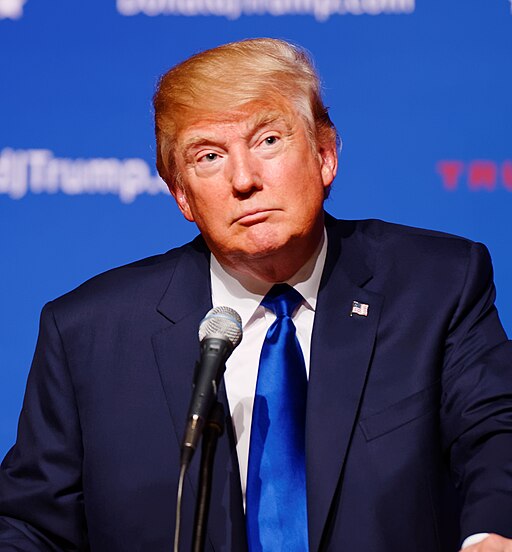
Photo by Michael Vadon [CC BY-SA 2.0], via Wikimedia Commons
Trump won all 57 delegates in Indiana.
This was the last stand of the anti-Trumps. Cruz announced he was dropping out shortly after the state was called for Trump. Kasich is still in it, but hasn’t shown any delegate gathering ability that would indicate he could make a difference.
Even with a loss in Indiana, Trump would almost certainly have won in the end. That has been clear for a couple weeks now. But he didn’t lose Indiana, he shut everyone else out completely.
Trump hasn’t wrapped things up quite yet, he still has to collect a few more delegates. But something unexpected and dramatic would have to happen to stop him from getting there.
The Republican race is now in the same state as the Democratic race has been for awhile. The outcome is known, and we’re just watching the winner mop up the last few delegates they need.
So time to look at the graphs:
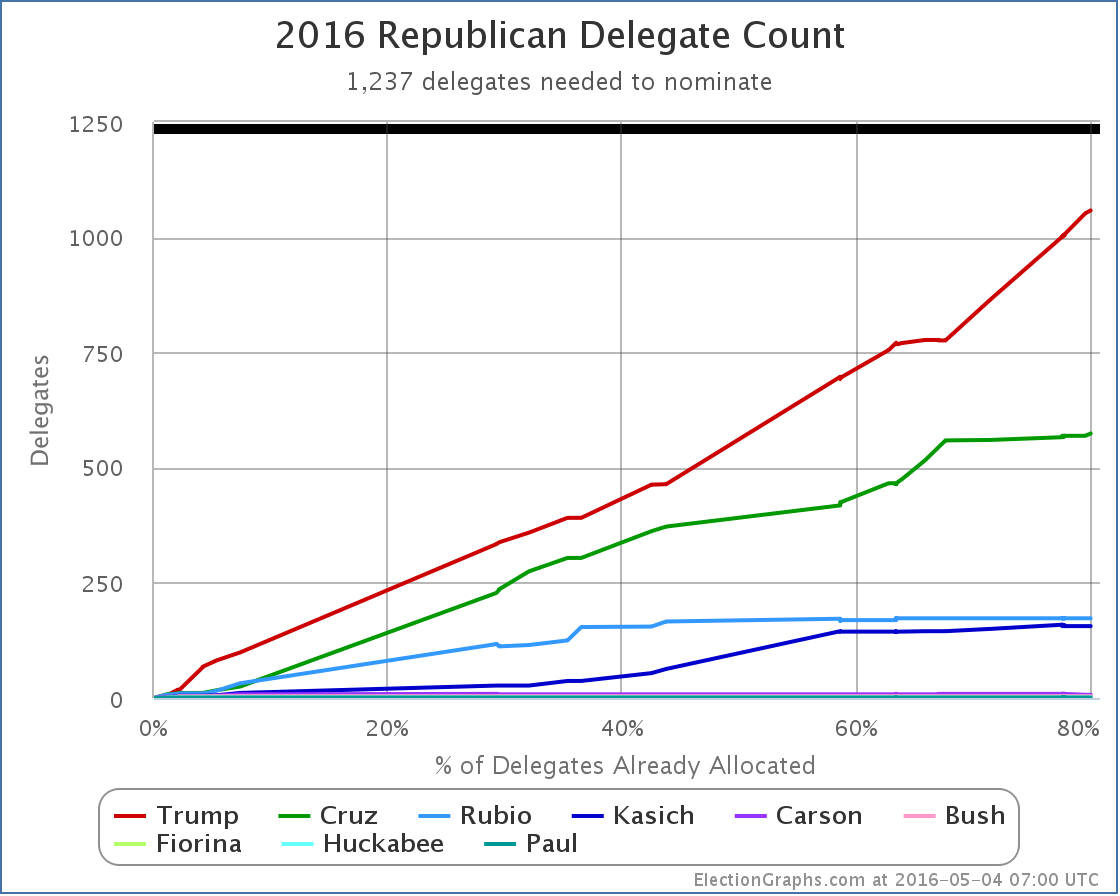
My best estimates of the delegate totals (including preferences of officially uncommitted delegates) is now:
Trump 1058, Cruz 574, Rubio 173, Kasich 156, Carson 7, Bush 4, Fiorina 1, Huckabee 1, Paul 1.
(In addition to the 57 delegates from Indiana for Trump, this includes adjustments since last week that total: Cruz +6, Kasich -2, Carson -2, Trump -3.)
This means Trump now needs 179 of the remaining 497 delegates to wrap this up.
Which brings us to the % needed chart:
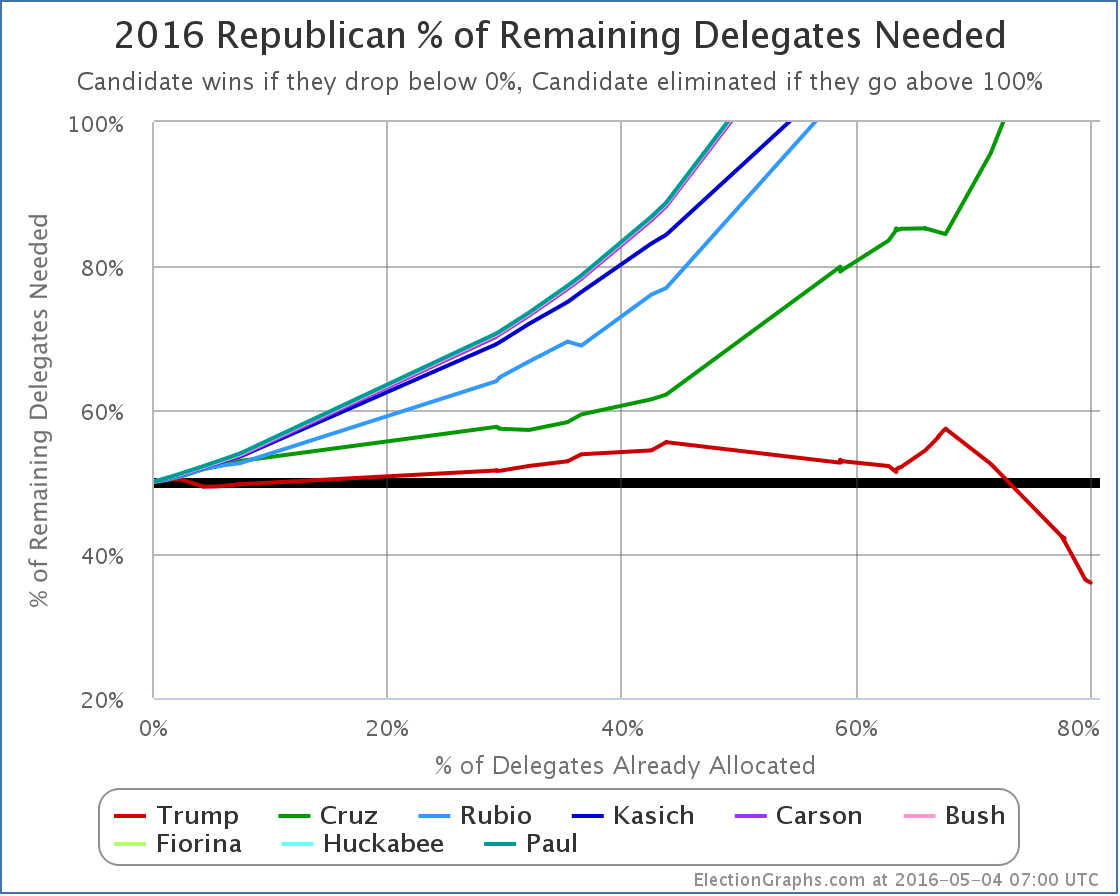
Trump now needs 36.02% of the remaining delegates to get to the magic number of 1237.
The remaining contests are essentially now just Trump vs Kasich. Unless you believe Kasich is suddenly going to start winning delegates in every remaining state by 64% to 36% margins despite getting less than 8% of the delegates so far, Trump will do what he needs to do. He will probably do much better than he needs to do.
So he will win, and he will win outright. No contested convention, just an outright win.
If there had been enough “Shadow anti-Trump” delegates… those that were pledged to Trump, but really supported someone else, then there may have been the ability to change the rules to unbind the delegates, opening up a back door for someone else to win even if Trump had the nominal majority. The fact that Cruz dropped out after Indiana indicates that those numbers just were not there…
And so we’re essentially done.
ElectionGraphs.com will continue to document this process, but now it is just a matter of watching Trump gather up the remaining delegates needed. There is no question any more how this will play out.
Unless a metaphorical meteor (or a literal one I guess) hits Clinton or Trump, we have our nominees. The general election is lined up. We are going to be watching Clinton vs Trump.
Update 2016-05-11 06:32 UTC – Adjustments from American Samoa’s uncommitted delegates, and Louisiana’s uncommitted delegates as well as Louisiana’s now free Rubio delegates. Net result: Trump +14, Cruz -3, Rubio -5.
Note: This post is an update based on the data on ElectionGraphs.com. Election Graphs tracks both a poll based estimate of the Electoral College and a numbers based look at the Delegate Races. All of the charts and graphs seen in this post are from that site. Additional graphs, charts and raw data can be found there. All charts above are clickable to go to the current version of the detail page the chart is from, which may contain more up to date information than the snapshots on this page, which were current as of the time of this post. Follow @ElectionGraphs on Twitter or like Election Graphs on Facebook to see announcements of updates or to join the conversation. For those interested in individual general election poll updates, follow @ElecCollPolls on Twitter for all the polls as they are added.
This week on the Curmudgeon’s Corner podcast Sam and Ivan spend most of the show on Election 2016. On the Republican side they discuss how recent results and the polls of upcoming states seem to be closing the door on the possibility of a contested convention and pointing to a straight up Trump nomination, as well as discussing Cruz/Fiorina, and what might make Trump worse than Cruz. On the Democratic side the discussion is on how Sanders seems to be finally admitting defeat, and on the veepstakes! Finally, they wrap it up with a lightning round covering all sorts of other issues they haven’t gotten around to lately.
Click below to listen or subscribe… then let us know your own thoughts!

Recorded 2016-04-28
Length this week – 1:40:24
 1-Click Subscribe in iTunes 1-Click Subscribe in iTunes
 View Podcast in iTunes View Podcast in iTunes
 View Raw Podcast Feed View Raw Podcast Feed
 Download MP3 File Download MP3 File
 Follow the podcast on Facebook Follow the podcast on Facebook
Show Details:
- (0:00:10-0:05:41) But First
- Agenda
- Noisy Ivan
- The Beep is Back
- (0:06:25-0:59:59) Election 2016: Republicans
- PA/MD/CT/RI/DE Results
- PA Uncommitted Delegates
- Where Trump is in the Delegate Race now
- Indiana Polls
- California Polls
- Projections for the rest of the race
- Bye Bye Contested Convention Scenarios
- Cruz/Kasich Deal
- Cruz/Fiorina 2016!
- Presidential Trump
- Trump Foreign Policy?
- Trump vs Cruz, who is worse?
- (1:01:07-1:10:29) Election 2016: Democrats
- Bernie admitting he is done?
- Veepstakes
- Median Voter vs Base
- (1:11:08-1:40:04) Lightning Round
- Bathroom Laws
- Germany/Turkey free speech issue
- Matthew Keys Case
- The Chalkening
- Tubman $20
- Movie: The Gentle Leader Way
- Brexit
- Prince
- Brazil
- Apple Earnings
- Saudi No Oil Plan
- Car vs Helicopter
Trump won New York 90 to 5. Those 5 delegates went to Kasich.
If there was any surprise here, it was that Trump got a few more delegates than expected. I didn’t track it in detail, but my impression was that most people expected a result in the 80’s.
In addition, since Wyoming there was an update to the delegate count in Georgia that moved one delegate from Trump to Cruz. So the net change since Wyoming was Trump +89, Kasich+5, Cruz +1.
So Trump got 93.68% of the delegates since Wyoming. He only needed 58.17% of the delegates. He easily cruised past this bar. So where does this put things?
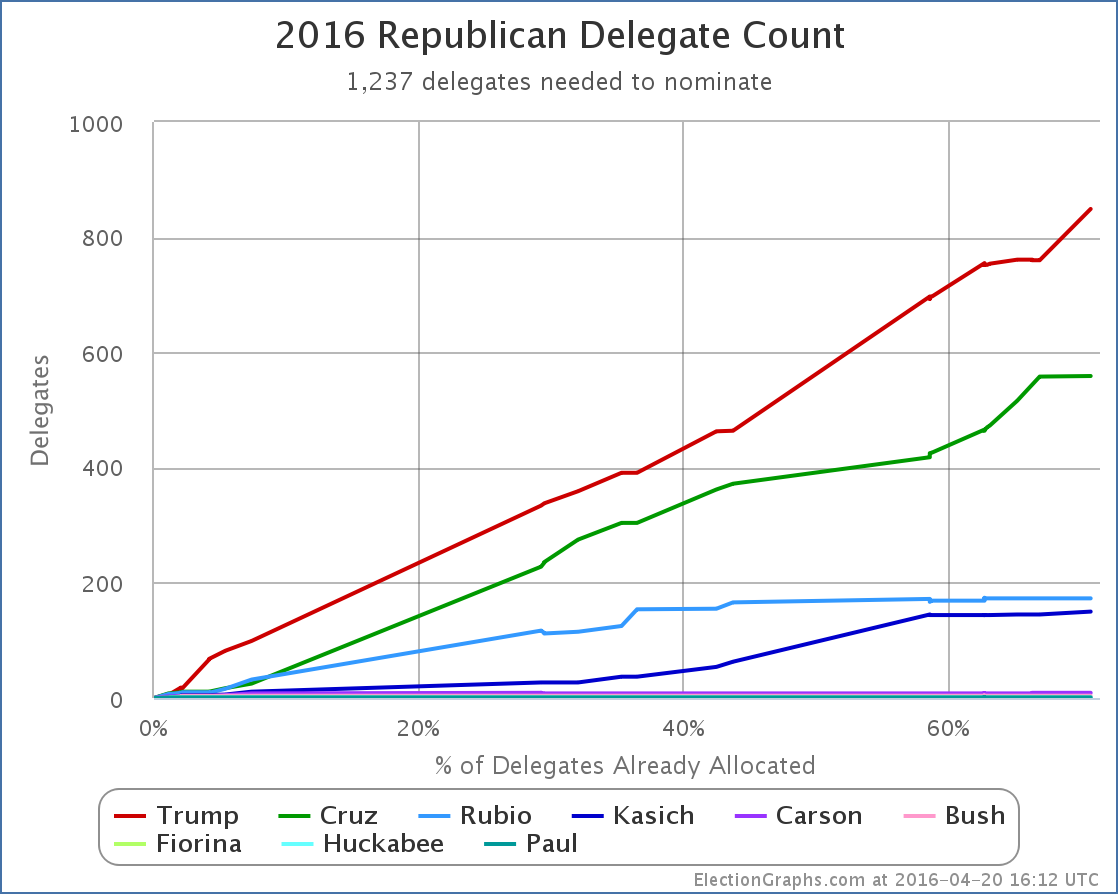
In raw delegates we now have Trump 849, Cruz 559, Rubio 173, Kasich 150, Carson 9, Bush 4, Fiorina 1, Huckabee 1, Paul 1. We have 725 delegates still outstanding or uncommitted. 1237 delegates are needed to win.
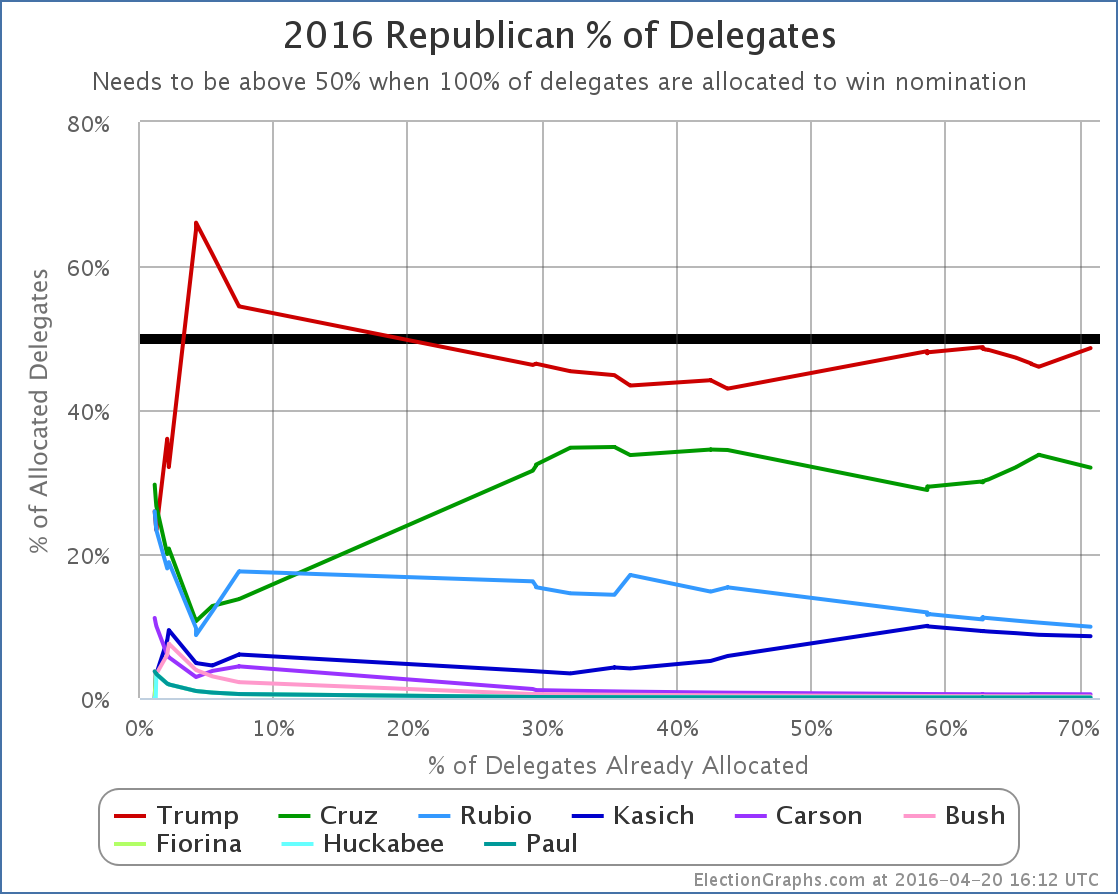
In percentage terms Trump now has 48.60% of the delegates determined so far. He is very very close to the magical 50% mark, but not quite there.
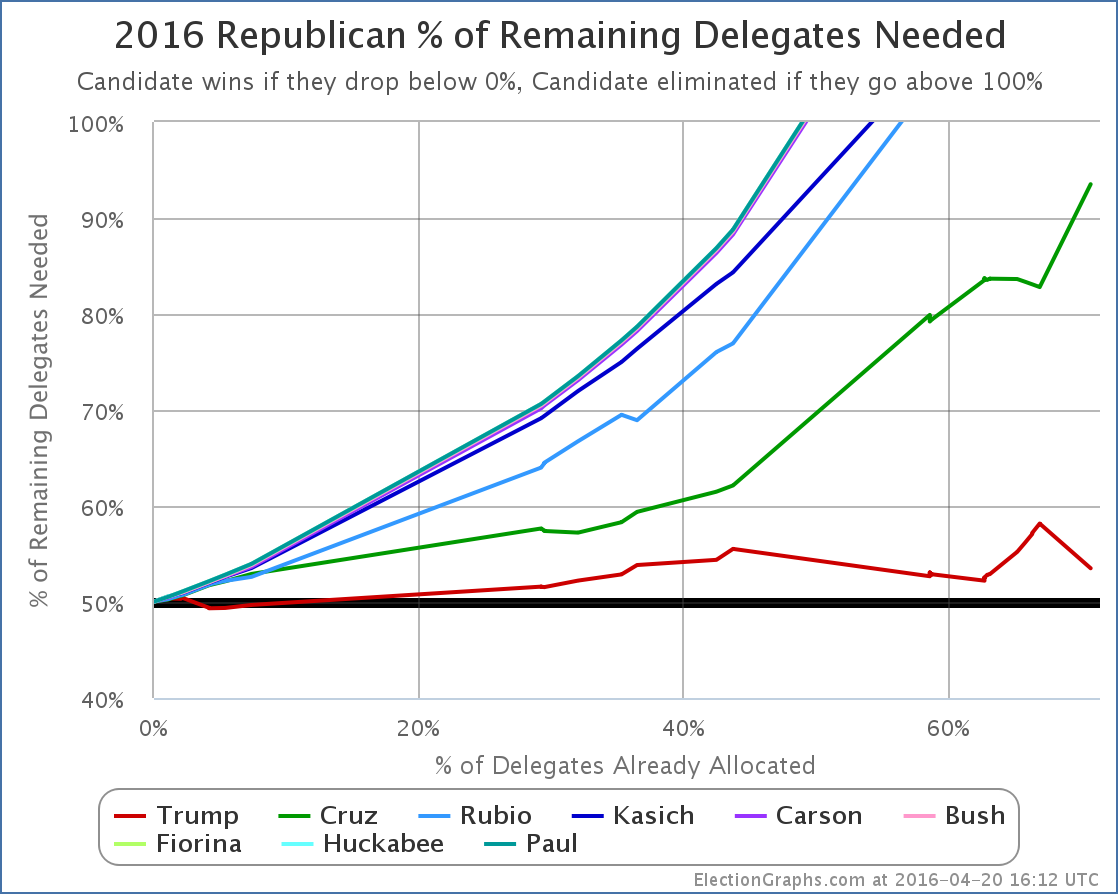
So time to look at the all important “% of remaining delegates needed” graph. As mentioned in the post here about Wyoming: If Trump did as well as was expected, he would undo most, but not all, of the damage done by Cruz’s recent series of wins, and that is exactly what played out.
Trump was down to 52.22% before his series of losses. After those losses he was up to 58.17%. Now he is back down to 53.52%.
Trump needs to get at least 53.52% of the remaining delegates… including officially uncommitted delegates… to get to 1237 and win this thing outright. Even one delegate short of that, and we’re in the multi-ballot convention zone.
The next few states are all very favorable for Trump. Next Tuesday we have Pennsylvania, Maryland, Connecticut, Rhode Island, and Delaware. Trump is expected to win all of them, by significant delegate margins. It is very possible that he will be over 50% of the delegates allocated so far at that point.
But then he has to keep it. Trump will still be right on the edge. He does a little worse, we have a multi-ballot convention, he does a little better, he wins on the first ballot.
So what are Trump’s odds of getting to 1237? This is unclear. But what is clear is that we are not yet at the point where we can say that either the path to an outright Trump win, or the path to a multi-ballot convention is undeniably the likeliest outcome.
Trump can still get an outright majority of delegates. This is very plausible. It is a reasonable possibility, not just a fantasy.
Some people (including me) have characterized this as a narrow path that Trump has to get nearly perfectly. That would seem to imply relatively low odds of this outcome. Maybe 10% or 20%. (Although I gave 40% as my odds in my podcast.)
On the other extreme, you have Sam Wang putting Trump’s odds of getting to 1237 at 64%. (That was before New York, but New York played out as good or better than Wang expected, so if anything that is now low.)
Looking at the simulators at The Upshot and FiveThirtyEight you see that it is still very easy to get Trump to the magic number. You usually have to use uncommitted delegates though. Trump will need to convince some more of them to come his way.
So maybe Trump is at 30% to win outright, or maybe he is at 64%. Either way, these are odds where either outcome would not be surprising. We’re basically still in the tossup zone. We are STILL right on the edge between Trump and a multi-ballot convention. And we might stay right on that edge straight through the end of the primaries and caucuses in June… or even all the way to the convention if the uncommitted delegates don’t start letting us know what their true preferences are.
Unlike the Democratic side, where Clinton has just been slowly but surely grinding out a win, here on the Republican side we have real drama. None of the others running can realistically win outright, but they CAN still stop Trump from winning outright and force a contested convention.
And so it continues…
[Update 2016-04-27 17:28 UTC: Updated uncommitted numbers from North Dakota. Net Cruz +2.]
Note: This post is an update based on the data on ElectionGraphs.com. Election Graphs tracks both a poll based estimate of the Electoral College and a numbers based look at the Delegate Races. All of the charts and graphs seen in this post are from that site. Additional graphs, charts and raw data can be found there. All charts above are clickable to go to the current version of the detail page the chart is from, which may contain more up to date information than the snapshots on this page, which were current as of the time of this post. Follow @ElectionGraphs on Twitter or like Election Graphs on Facebook to see announcements of updates or to join the conversation. For those interested in individual general election poll updates, follow @ElecCollPolls on Twitter for all the polls as they are added.
In my last post on the Republicans I used current polls to try to guess the March 15th results. This was my guess:
Trump +226, Kasich +86, Cruz +36, Rubio +19
Results are not yet final in Missouri, and because it is winner take all in each congressional district as well as statewide, and it is close in most congressional districts, things could still swing there quite a bit. But for the moment, with the best estimates I had from Green Papers, the actual results from the 15th were:
Trump +229, Kasich +81, Cruz +51, Rubio +6
Cruz got a bit more than my predictions, Rubio a bit less. But basically using the polls a couple days out got things pretty spot on. So minus any big changes from Missouri or minor adjustments elsewhere, this was the expected scenario.
So time to look at some graphs, including some I don’t usually bother with…
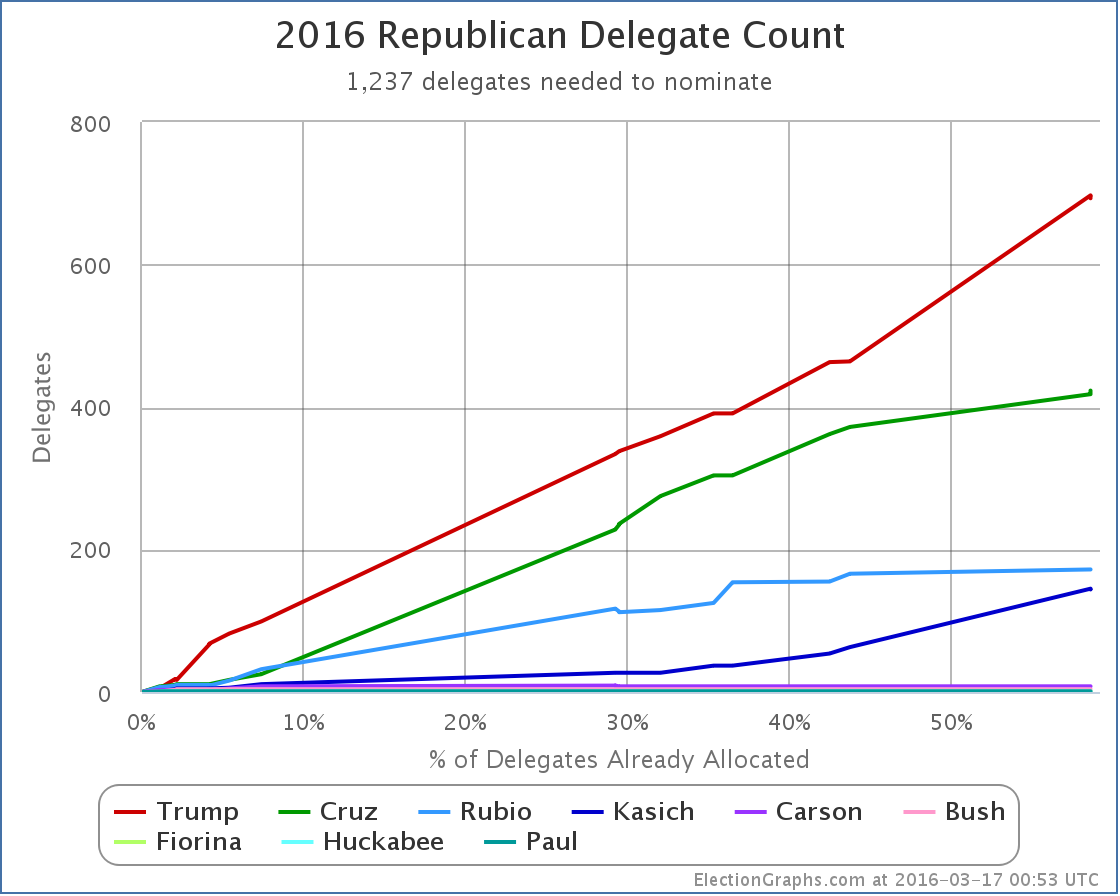
In raw delegate counts we now have:
Trump 693, Cruz 423, Rubio 172, Kasich 144, Carson 8, Bush 4, Fiorina 1, Huckabee 1, Paul 1
Trump, Cruz and Kasich both look like they made significant improvements, but…
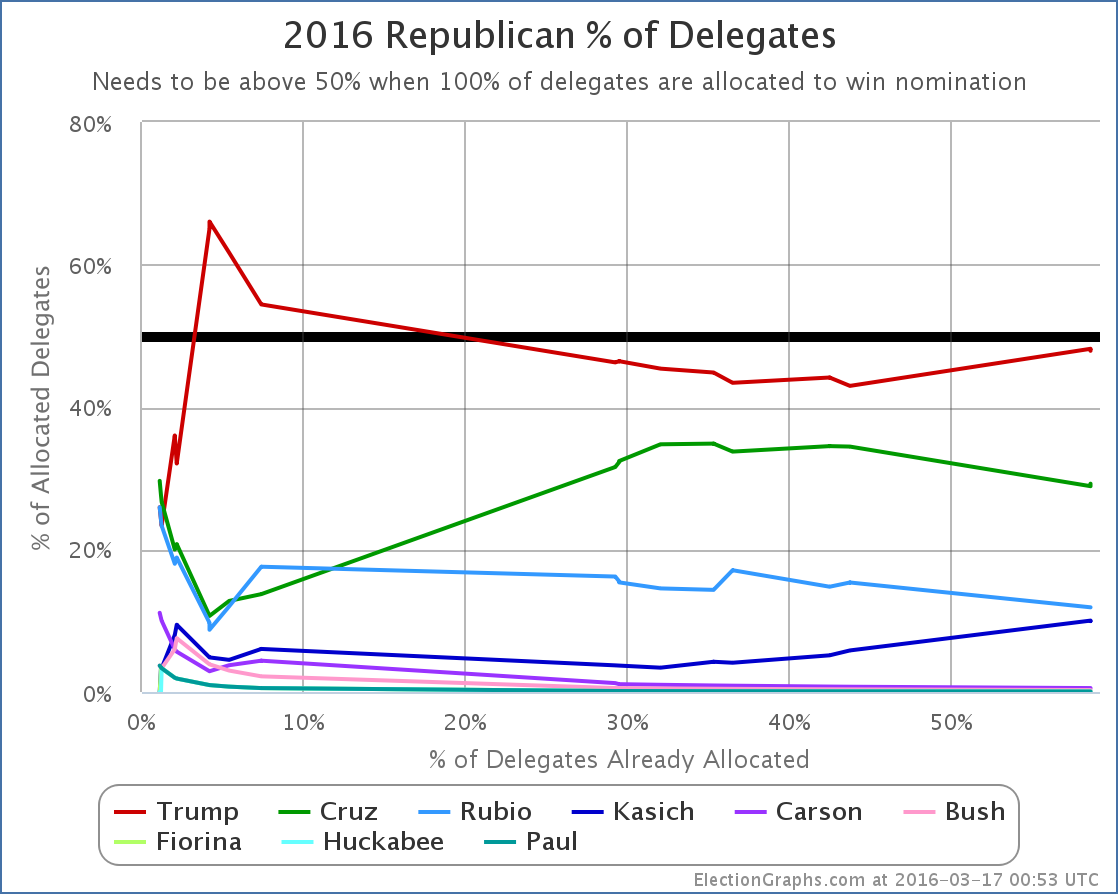
This is the percentage of delegates allocated so far to each candidate. Trump is just BARELY under the 50% mark. Only Trump and Kasich improved on this metric with the March 15th results.
But… looking at the much more useful “% of remaining delegates needed to win” graph…
Everybody except Trump got further away from the nomination after March 15th. In fact, all of them got a LOT farther from the nomination. In fact, almost all the candidates have now been mathematically eliminated from a first round convention win. We knew for a long time that Paul, Huckabee, Fiorina, Bush and Carson were headed there. But it is now official. But Rubio was also eliminated. And despite his “big win” in Ohio, so was Kasich. All of these candidates could get every delegate still outstanding… and still not end up with enough delegates to win.
Only Trump and Cruz still have the possibility of collecting a majority of the delegates before the convention. And Cruz just went from needing 62.14% of the remaining delegates, to needing 79.41%. This is a completely unrealistic number, even if it was a two person race between him and Trump. (For the moment, despite it being impossible for him to get enough delegates, Kasich is staying in, so we still have a three way split, which favors Trump.)
Trump needs 53.07% of the remaining delegates to win outright. Less than that will get us to a contested convention and all kind of chaos. But how likely is Trump to get those sorts of margins? So far of course he has only gotten 47.89% of the delegates. So he does have to improve on his previous performance by about 11%.
This sounds like a lot, but it is probably quite reachable. First, Trump will undoubtedly pick up some of Rubio’s supporters, they won’t all go to Cruz and Kasich. Second, there are a number of winner take all states coming up. Third, a lot of the states that are not winner take all are still winner take most.
Basically, the structure of the primary calendar is DESIGNED to help the front running candidate wrap things up. It is not unreasonable to think Trump will be able to do that. To stop it, Cruz and Kasich between them need to be getting more than a majority of the delegates despite the fact that neither of them has a realistic shot at an outright win. The only plan for those two is to force the contested convention, then win there.
Some places have tried to game out all of the remaining primaries and caucuses, and they conclude that we may in fact not know if we have an outright Trump win or a contested convention until the very last contests on on June 7th. That would be California, Montana, New Jersey, New Mexico and South Dakota. And there is a possibility we won’t even know until after that, because although their numbers are small, some states and territories have actually elected uncommitted delegates, who like superdelegates on the Democratic side are free agents able to vote however they see fit. There is a posisbility (a small one, but non-zero) that these uncommitted delegates may be in a position to determine if there will indeed be a contested convention.
I won’t try to game out the rest of the season, but I will look at next Tuesday… Arizona, Utah, and American Samoa. As usual, looking at RCP for polls, and Green Papers for delegate rules. But guess what? As of today, there has been NO recent polling on any of these three. So we’ll use national polling, but eliminating candidates who have dropped out. So Trump 36.0%, Cruz 21.8%, Kasich 12.0%. Normalized to 100%, that is Trump 51.6%, Cruz 31.2%, Kasich 17.2%..
- Arizona is winner take all. Unless Cruz or Kasich are doing much better there than nationally, Trump gets all 58 delegates.
- Utah is winner take most. If anybody gets over 50%, they get all the delegates. If the estimates above based on national polling are right, Trump gets all 40 delegates. If he doesn’t hit 50%, but still gets a plurality, he is likely to still get almost all the delegates. We’ll estimate 40 to Trump.
- American Samoa might end up electing someone with a commitment, but the expectation given their rules is that all delegates will be uncommitted, so they will just stay TBD in my counts.
Now, either Arizona or Utah COULD go in a completely different direction. As I said, there has been no recent polling. So who really knows? But if Trump ends up winning both, he will likely get something close to 98 delegates out of the two states.
If that happened, that would put the total delegate count at:
Trump 791, Cruz 423, Rubio 172, Kasich 144, Carson 8, Bush 4, Fiorina 1, Huckabee 1, Paul 1
That would give Trump 51.20% of the delegates. He would once again have a majority of the delegates. Trump would then need 446 delegates to win outright. There would be 927 delegates left undetermined at that point. So Trump would only need 48.11% of the remaining delegates to win. Which given his history at that point seems quite reachable.
But continuing to block him might still be within reach. Cruz + Kasich would only need to manage about 52% of the delegates. Which might be possible if they could build on anti-Trump sentiment even in the face of Trump winning. If they can do that is a big open question though. The “I can’t win, and you might not even like me, but vote for me to block the other guy and cause a contested convention where the outcome is completely unknown” case may not be the easiest one to make.
But if Cruz and Kasich can make that case, then it is not over yet.
So then we start looking at North Dakota, Wisconsin, Colorado… and beyond.
Of course, if Trump loses Arizona or Utah, that all changes.
So we will have to wait and see… but if I had to put odds on it, I’m still thinking about an 80% chance that Trump just wins this outright. The structure of the contests themselves are designed to help the front runner, and that is Trump.
[Update 2016-03-18 06:21 UTC – As per Alaska’s rules, after Rubio dropped out they reassigned his delegates to the remaining candidates. Result: Trump +3, Cruz +2, Rubio -5.]
[Update 2016-03-23 01:43 UTC – The Virgin Islands updated their delegate results because the original slate of delegates (all uncommitted) did not end up qualifying under the rules (see here). The original delegates were replaced by alternates. The result for the counts was Rubio +2, Cruz +1, Trump +1.]
Note: This post is an update based on the data on ElectionGraphs.com. Election Graphs tracks both a poll based estimate of the Electoral College and a numbers based look at the Delegate Races. All of the charts and graphs seen in this post are from that site. Additional graphs, charts and raw data can be found there. All charts above are clickable to go to the current version of the detail page the chart is from, which may contain more up to date information than the snapshots on this page, which were current as of the time of this post. Follow @ElectionGraphs on Twitter or like Election Graphs on Facebook to see announcements of updates or to join the conversation. For those interested in individual general election poll updates, follow @ElecCollPolls on Twitter for all the polls as they are added.
[Edit 02:27 UTC to add final bit about odds.]
Saturday brought Republican results for DC, Guam and Wyoming. The number of delegates coming out of this was small, turnout was tiny, and there had been no polling. But the results were surprisingly bad for Trump. Between these three we ended up with:
Rubio +11, Cruz +10, Kasich +9, Trump +1
This by the way is much worse for Trump than the model in my last post predicted, since it used national polls in the absence of actual polls for these three places.
There were also 9 “uncommitted” delegates selected yesterday. These people essentially become like the Democratic superdelegates, in that they are free agents at the convention. If I find out their preferences, I’ll assign them to the candidate they support, but for now they remain TBD. With all the contests so far there are actually 22 of these now. It will be interesting to see if they make a difference.
In any case, with only 1 of 30 delegates from Saturday, or 3.33%, Trump fell very far short of the 54.39% of the delegates he needed to be on the path to an outright win instead of a contested convention.
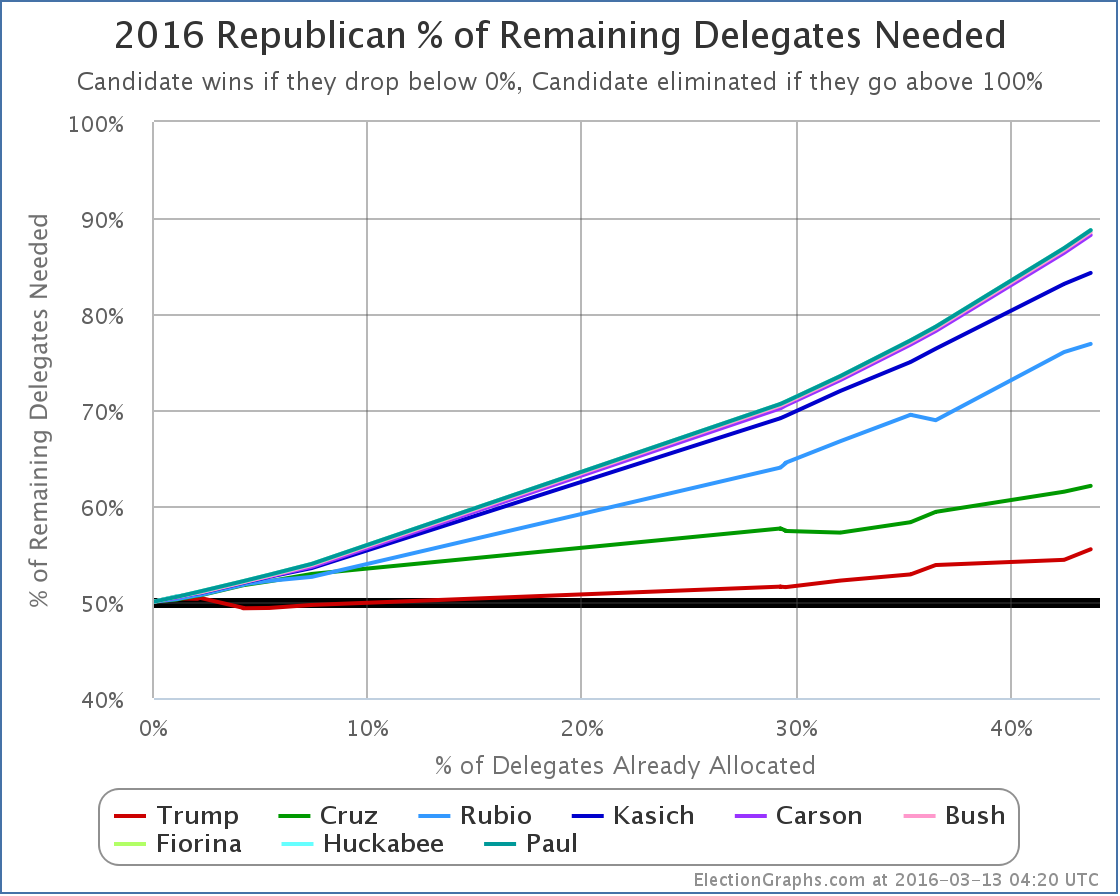
Trump now needs 55.49% of the remaining delegates to win outright. This number is getting high. And the gap between what Trump has done so far (42.96% of delegates) is getting larger. Nobody else got what they needed either of course, so everybody’s numbers got worse, not just Trump’s.
Of course, we still have some big winner take all and winner take most states coming up, so time to refresh the poll based predictions for Tuesday and see what they look like now. As usual, using RCP poll averages and delegate distribution rules from Green Papers.
Florida – 99 delegates – March 15th:
- Poll averages: Trump 41.4%, Rubio 23.3%, Cruz 19.7%, Kasich 9.6%
- Delegate estimate: Trump 99
North Carolina – 72 delegates – March 15th:
- Poll averages: Trump 35.6%, Cruz 23.8%, Rubio 13.0%, Kasich 10.4%
- Delegate estimate: Trump 31, Cruz 21, Rubio 11, Kasich 9
Illinois – 69 delegates – March 15th:
- Poll averages: Trump 34.3%, Cruz 25.3%, Kasich 18.3%, Rubio 14.8%
- Delegate estimate: Trump 35, Cruz 15, Kasich 11, Rubio 8
Ohio – 66 delegates – March 15th:
- Poll averages: Kasich 35.3%, Trump 33.3%, Cruz 20.0%, Rubio 5.8%
- Delegate estimate: Kasich 66
Missouri – 52 delegates – March 15th:
- Using only recent poll: Trump 36.0%, Cruz 29.0%, Rubio 9.0%, Kasich 8.0%
- Delegate estimate: Trump 52
Northern Marianas – 9 delegates – March 15th:
- No polls, using national avg: Trump 36.0%, Cruz 21.8%, Rubio 18.0%, Kasich 12.0%
- Delegate estimate: Trump 9
The main difference from the estimate a few days ago is that now Kasich is ahead in Ohio, and wins the 66 delegates there. This makes a big difference.
Adding these up:
Trump +226, Kasich +86, Cruz +36, Rubio +19
Trump would get 61.6% of the delegates on Tuesday. Which even without Ohio would be above the 55.49% he needs to be tracking toward a clean win.
The new totals would be:
Trump 690, Cruz 408, Rubio 185, Kasich 149, Others 15
Trump would have 47.7% of the delegates. Still not a majority.
When you do all the math at the end of all that, Trump would need 53.37% of the remaining delegates to cleanly win a majority of the delegates. That would still be a substantial improvement from what he had been doing so far.
But there would be more winner take all states coming up. And Cruz, Rubio and Kasich would be so far behind that the scenarios where they would catch up would be extremely far fetched. None of them can win outright. At best they can block Trump. Do all three of them stay in? Do their donors continue to support them in a bid where the only real goal is a contested convention? Can they really keep blocking him from getting a majority of the delegates through a long slog from now until June 7th?
The “Trump wins Florida, but loses Ohio” scenario is the one where it would be premature to say either “Trump will win this outright”, or “Contested Convention”. Instead, we’ll still be hovering between those possibilities, waiting for more states to weigh in.
This might go on awhile.
Finally, as I did with the Democrats earlier, a quick look back, comparing Trump today with Romney in 2012 and McCain in 2008.
First, just looking at the percent of delegates they had as the race progressed:
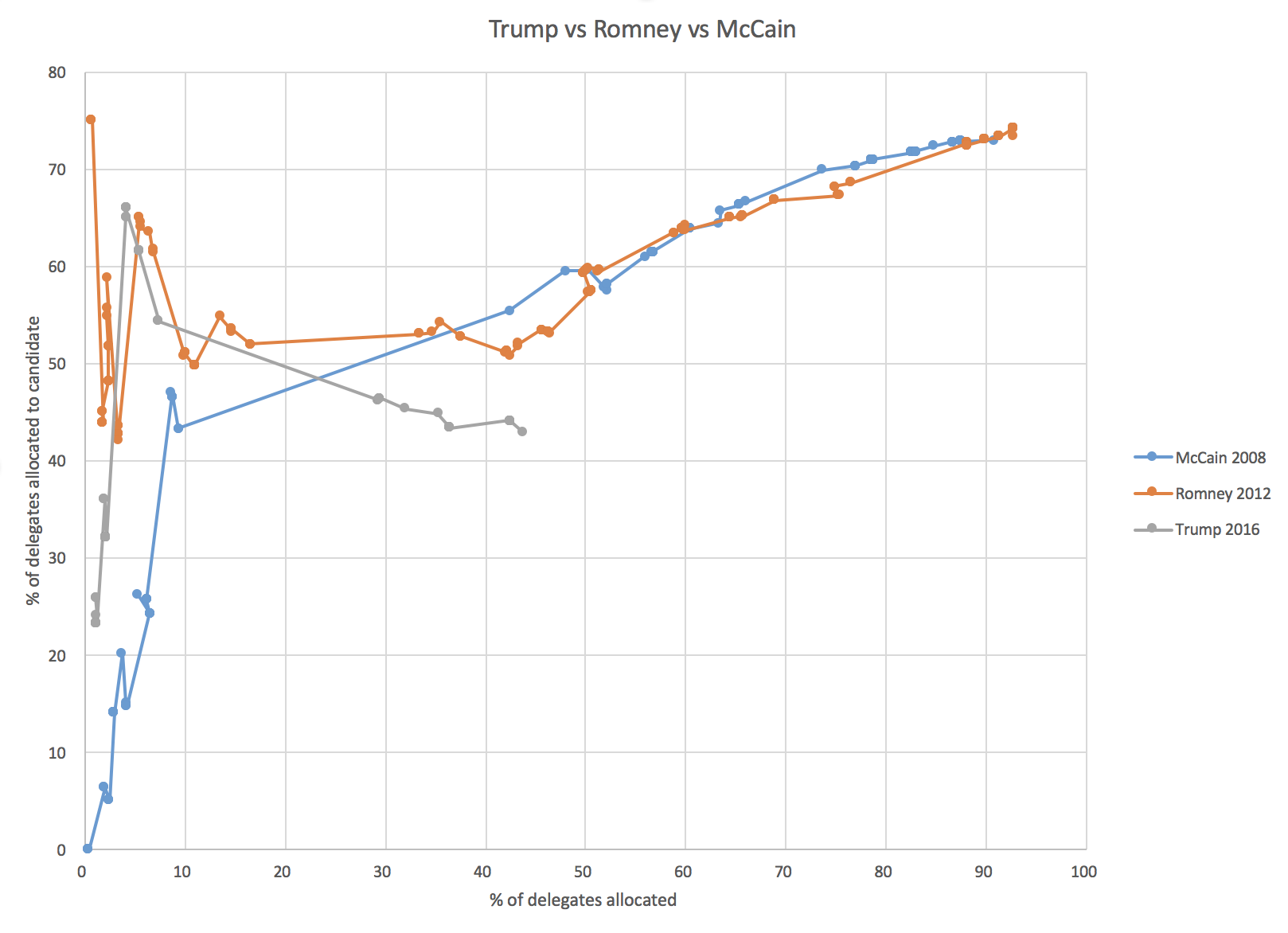
You can see that Trump is behind where either McCain or Romney were at about the same point in the race. But as I’ve said many times, percentages of delegates so far is the wrong way to look at things. Instead, you want to look at the % of the remaining delegates that are needed:
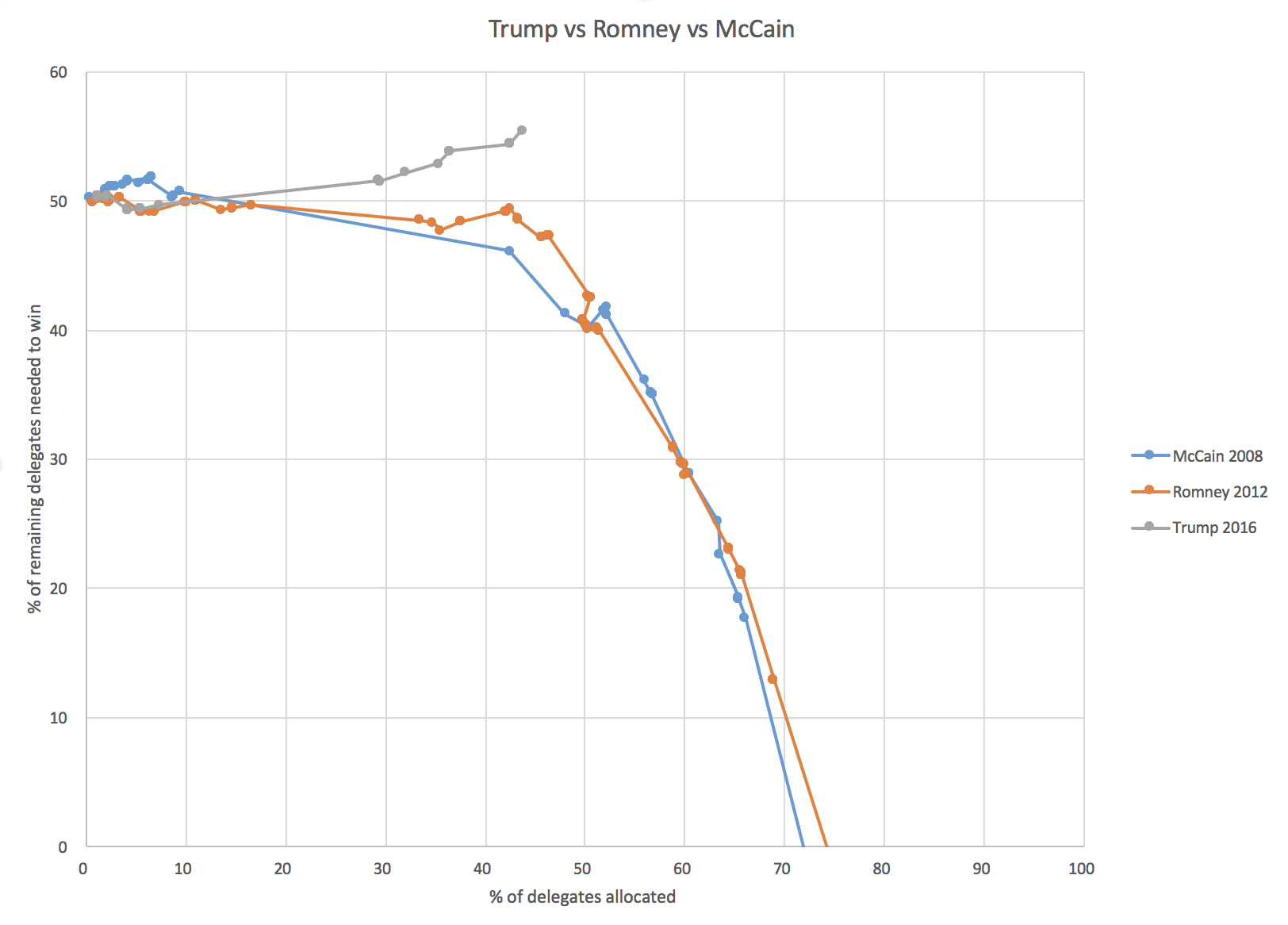
You can see that at this point in the race, both Romney and McCain needed less than 50% of the remaining delegates to win. Trump is way behind that pace. But it was also not until right around now in the races that McCain and Romney really started to pull away. Trump has a harder road here, but with a handful of big winner take all states it is not too late for him to start a downward dive to a flat out win.
But if his line doesn’t manage a full on turn downward, eventually it will curve up, and we’ll end up at the contested convention.
Ohio is close. We will have to wait until Tuesday to see how this thing is going…
Note: This post is an update based on the data on ElectionGraphs.com. Election Graphs tracks both a poll based estimate of the Electoral College and a numbers based look at the Delegate Races. All of the charts and graphs seen in this post are from that site. Additional graphs, charts and raw data can be found there. All charts above are clickable to go to the current version of the detail page the chart is from, which may contain more up to date information than the snapshots on this page, which were current as of the time of this post. Follow @ElectionGraphs on Twitter or like Election Graphs on Facebook to see announcements of updates or to join the conversation. For those interested in individual general election poll updates, follow @ElecCollPolls on Twitter for all the polls as they are added.
[Edit 22:17 UTC to add sentence about other candidate’s numbers getting worse, not just Trump’s.]
[Edit 22:32 UTC to add link to the post on the Democrats.]
On the Republican side March 9th brought results from Hawaii, Idaho, Michigan and Mississippi. The results were:
Trump +73, Cruz +59, Kasich +17, Rubio +1
The projections I made a few days ago based on polling were:
Projected total for March 8th: Trump +91, Cruz +28, Rubio +18, Kasich +12, Carson +1
Despite his wins, Trump considerably underperformed what his polling indicated just a couple days beforehand, while Cruz beat his estimates by quite a bit. Rubio, well, Rubio just flamed out.
Now, this is still a Trump win, but the fact that it was less than the polls would have predicted may mean that there is weakness in Trump that is not being captured by the latest polls.
Also, it was not enough to put him on track to get back out of the “contested zone” where we are on track for a contested convention, and back to a place where he actually has a majority of the delegates.
Lets look at the “% of remaining delegates needed to win” graph:
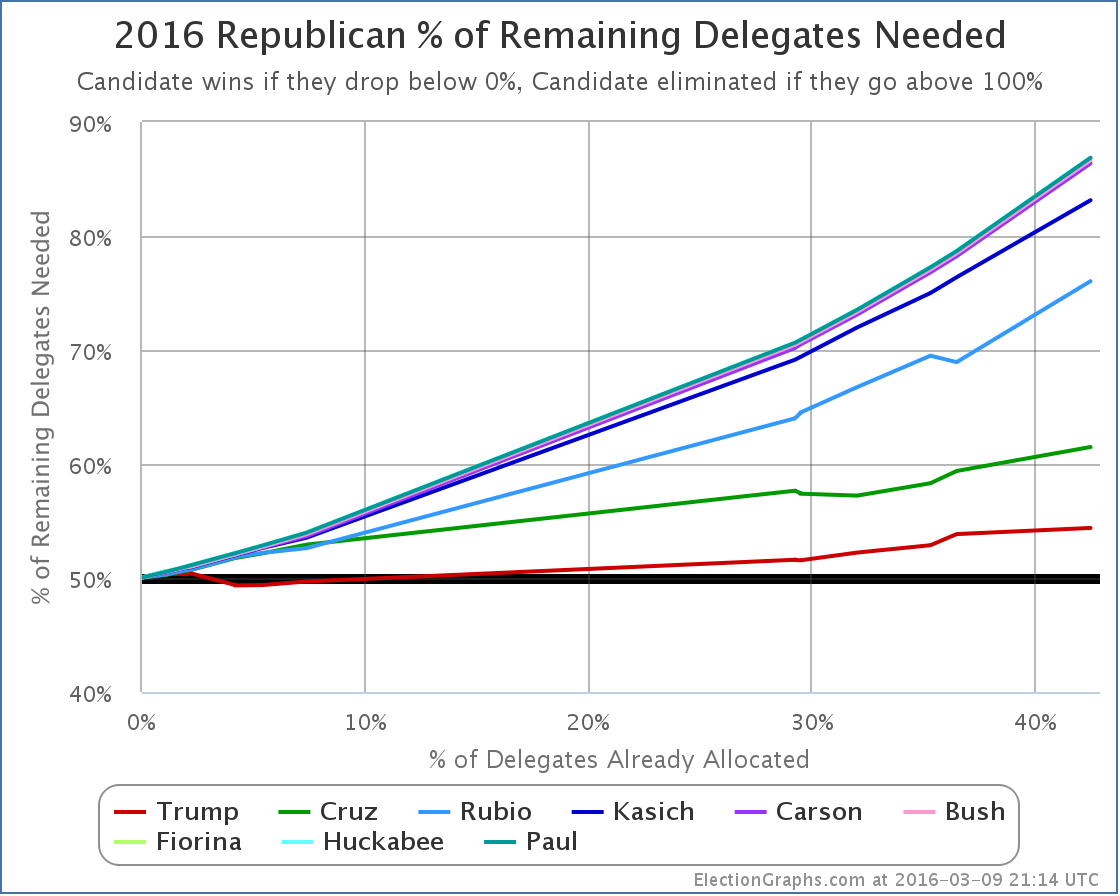
Before today, Trump needed 53.85% of the delegates to be on track for an outright win. For the night he got 48.67% of the delegates. Not quite there. So his % needed for the next contests increases to 54.39%.
This is getting high given that his history to date is only getting 44.14% of the delegates. He needs to improve his rate of delegate acquisition by about 23% to head toward an outright win.
If the remaining states were all straight proportional, it might already be time to start saying the likelyhood of the contested convention was getting to the point that anything else would be a surprise.
But the Republican contests are almost all biased at least a little bit to the winner, and starting March 15th, we have a number of high delegate winner take all states, most notably Florida and Ohio.
As I’ve been doing, lets look at the next few contests. This time lets go all the way through the big March 15th day. As usual, using RCP poll averages and delegate distribution rules from Green Papers.
Florida – 99 delegates – March 15th:
- Poll averages: Trump 40.2%, Rubio 24.4%, Cruz 17.4%, Kasich 8.4%
- Delegate estimate: Trump 99
North Carolina – 72 delegates – March 15th:
- Poll averages: Trump 32.7%, Cruz 21.7%, Rubio 15.3%, Kasich 9.7%
- Delegate estimate: Trump 30, Cruz 20, Rubio 14, Kasich 8
Illinois – 69 delegates – March 15th:
- Poll averages: Trump 32.7%, Rubio 18.7%, Cruz 17.7%, Kasich 13.3%
- Delegate estimate: Trump 37, Rubio 12, Cruz 11, Kasich 9
Ohio – 66 delegates – March 15th:
- Poll averages: Trump 39.0%, Kasich 34.0%, Cruz 15.3%, Rubio 7.0%
- Delegate estimate: Trump 66
Missouri – 52 delegates – March 15th:
- No recent polls, using national avg: Trump 36.0%, Cruz 21.8%, Rubio 18.0%, Kasich 12.0%
- Delegate estimate: Trump 52
Wyoming – 29 delegates – March 12th:
- No recent polls, using national avg: Trump 36.0%, Cruz 21.8%, Rubio 18.0%, Kasich 12.0%
- Delegate estimate: Trump 12, Cruz 7, Rubio 6, Kasich 4
District of Columbia – 19 delegates – March 12th:
- No recent polls, using national avg: Trump 36.0%, Cruz 21.8%, Rubio 18.0%, Kasich 12.0%
- Delegate estimate: Trump 9, Cruz 5, Rubio 5
Virgin Islands – 9 delegates – March 10th:
- No recent polls, using national avg: Trump 36.0%, Cruz 21.8%, Rubio 18.0%, Kasich 12.0%
- Delegate estimate: Trump 4, Cruz 2, Rubio 2, Kasich 1
Guam – 9 delegates – March 12th:
- No recent polls, using national avg: Trump 36.0%, Cruz 21.8%, Rubio 18.0%, Kasich 12.0%
- Delegate estimate: Trump 4, Cruz 2, Rubio 2, Kasich 1
Northern Marianas – 9 delegates – March 15th:
- No recent polls, using national avg: Trump 36.0%, Cruz 21.8%, Rubio 18.0%, Kasich 12.0%
- Delegate estimate: Trump 9
Now, lots of assumptions there. Also, Wyoming and some of the territories are actually directly electing delegates and we may not know their preferences on election night, so they may be listed as unbound or TBD for awhile. But lets do the addition anyway. From the above we end up with:
March 10th to March 15th estimate: Trump 322, Cruz 47, Rubio 41, Kasich 23
That would give Trump a whopping 74.36% of the delegates, well above the 54.39% he needs.
Now, because that includes some big winner take all, and some more that are winner-take-most, that is highly volatile. If he loses Florida… or Ohio, where the race is a lot closer… then things start to look worse for Trump very quickly. In terms of winning outright… not necessarily in terms of keeping the delegate lead.
But given the results above, does Trump get back to a delegate majority?
The new totals would be:
Trump 785, Cruz 409, Rubio 196, Kasich 77, Others 15
Trump would have 52.97% of the delegates. He would be back on track for an outright win.
Not only that, but 1482 of the 2472 delegates would already have been allocated. That is just a hair under 60%. Only 990 delegates would be left. And Trump would already have 785 of the 1237 delegates he would need to win outright. So he would only need 452 more delegates… or 45.66% of the remaining delegates. Which would probably be an easy ask given where the campaign would be at that point and the number of winner take all and/or winner take most states coming up. If he wins both states, the chances of a contested convention drop dramatically. We’re almost certainly looking at a clean Trump win.
Take away Ohio and Trump would no longer have a majority at this stage, and would still need 52.32% of the remaining delegates to win outright. This would still be very doable, just a little bit harder. In this scenario, we might be hanging on the edge between the contested convention and the Trump win for awhile.
Take away Ohio AND Florida and not only would Trump not have a majority, but he would need a full 62.32% of the remaining vote to win outright. This number would be more difficult to achieve, and the chances of a contested convention would then be very very high.
Now, this of course assumes the results are somewhat similar to the projections above in the other states too… but the general outlines of this are likely to remain true.
Where we are after March 15th will depend in huge part on Florida and Ohio. Right now Trump is way ahead in Florida, and has a slim lead in Ohio. But Trump has been underperforming his polls lately. If that trend continues, things may be closer than they look right now.
There are five and a fraction days left, including one more debate. So there is room for considerable movement as well.
But Trump has a significant advantage at this point. We are currently in the “contested convention” zone… but Trump is in a very good position to knock us out of there and into the “Trump wins” zone.
Note: This post is an update based on the data on ElectionGraphs.com. Election Graphs tracks both a poll based estimate of the Electoral College and a numbers based look at the Delegate Races. All of the charts and graphs seen in this post are from that site. Additional graphs, charts and raw data can be found there. All charts above are clickable to go to the current version of the detail page the chart is from, which may contain more up to date information than the snapshots on this page, which were current as of the time of this post. Follow @ElectionGraphs on Twitter or like Election Graphs on Facebook to see announcements of updates or to join the conversation. For those interested in individual general election poll updates, follow @ElecCollPolls on Twitter for all the polls as they are added.
The Republican Super Tuesday is over with the exception of a handful of delegates that were still undetermined when it was time for me to start writing up the results.
Last Tuesday I used polling to project what Super Tuesday would look like for the Republicans. The projection looked like this:
Estimate: 294 Trump, 246 Cruz, 67 Rubio, 11 Kasich, 6 Carson
We’ll dispense with the state by state totals, and jump right to the final results:
Actual: 252 Trump, 211 Cruz, 101 Rubio, 16 Kasich, 4 Carson, 6 TBD
The 6 that are still to be determined as of this update are from Tennessee (3 delegates) and Texas (3 delegates), but they won’t make much of a difference here.
The poll based estimates were not quite as close as they were for the Democrats. This may simply be because I did the estimates a full week out based on relatively sparse polling. There were a lot of polls in that last week, and it may well be that the results would have been closer if I had redone the analysis on Monday.
The general outlines of the estimate and the analysis based on them were basically correct though. The one notable difference is that Rubio did considerably better than the estimates, at the expense of both Trump and Cruz’s delegate totals. It appears that Rubio’s week of anti-Trump crusading may have worked.
The main consequence is that Trump was pushed a bit further away from the levels he needed to actually improve his position relative to last week. He was expected to lose ground anyway, but he lost more than it looked like he was going to. It was enough to push Trump back down below 50% of the delegates allocated so far:
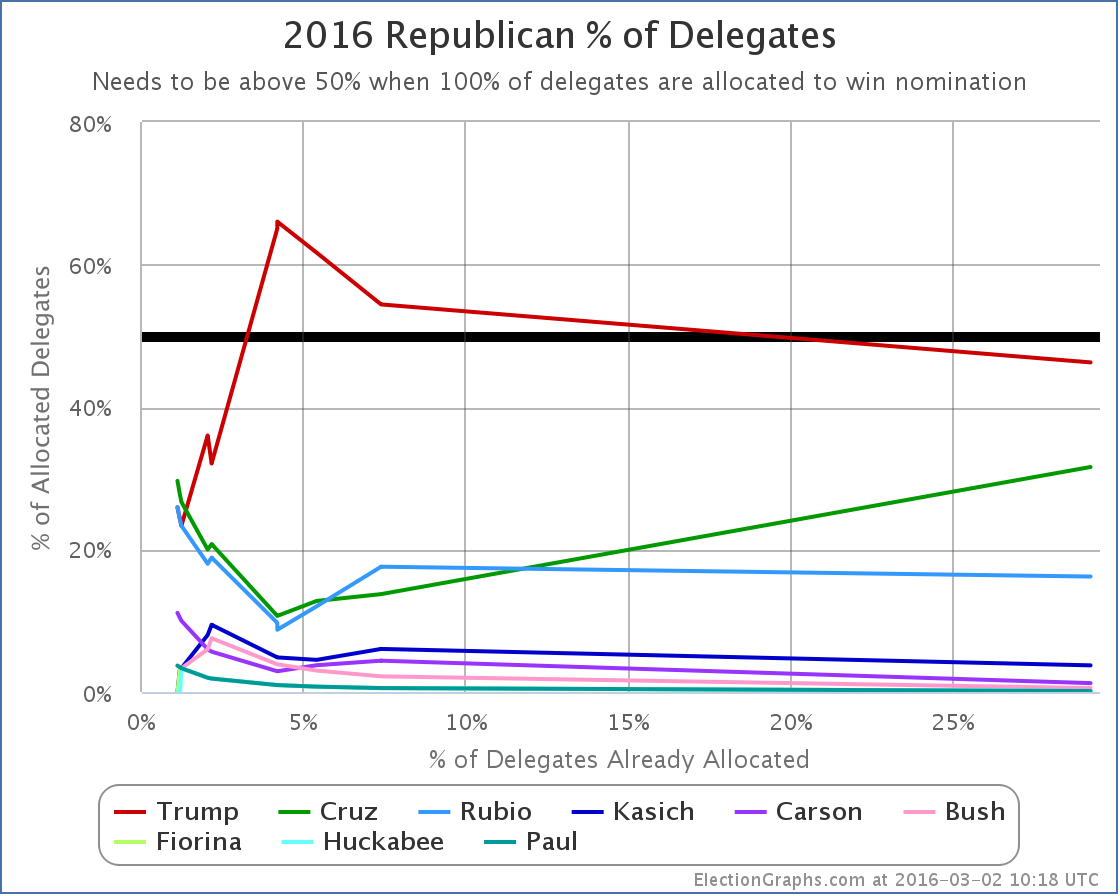
On this metric, Cruz looks like he did the best coming out of Super Tuesday. But this is the wrong number to be looking at. The all important thing to be looking at is the “% of remaining delegates needed to win”:
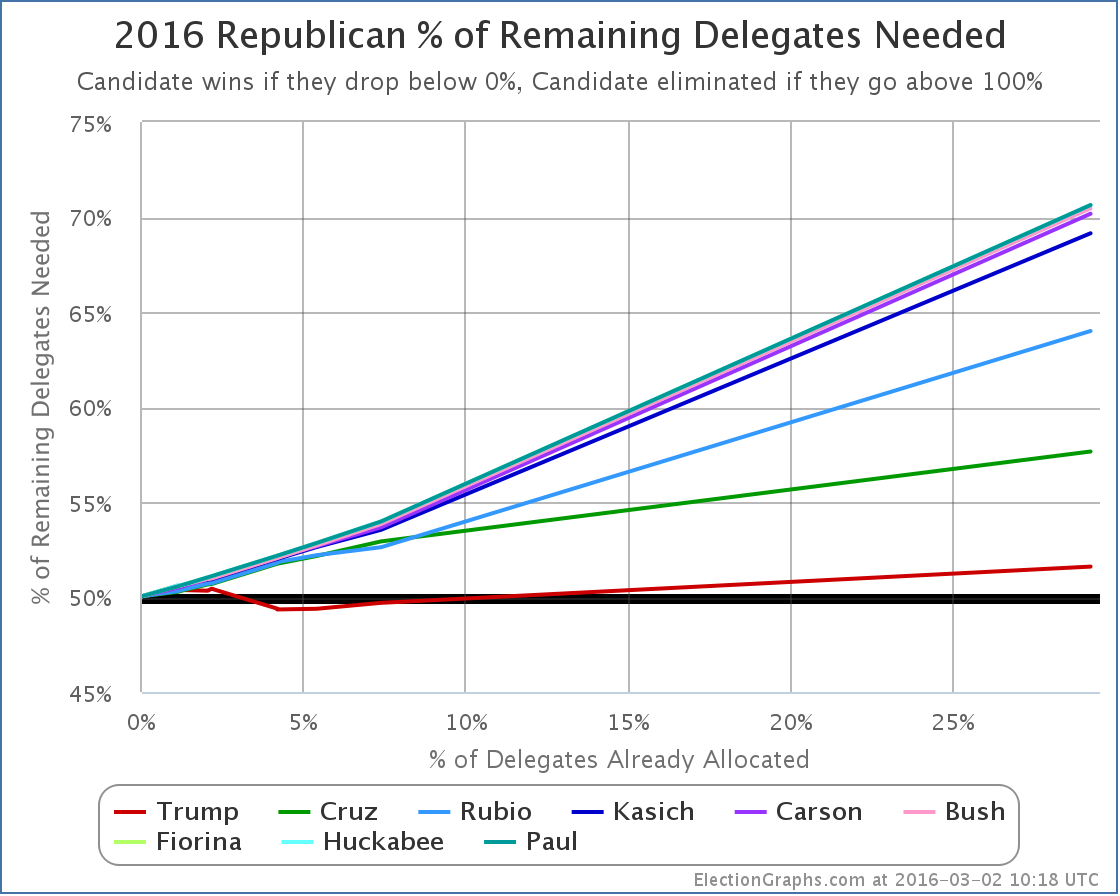
Everybody’s position got worse! (Remember down is good on this chart… getting down to 0% means you win, going up to 100% means you are eliminated.)
Trump needed to get 49.4% of the Super Tuesday delegates to improve his position in terms of getting to a clean first ballot win. Instead, he got 43.1% of the delegates so far. So his “% of remaining delegates to win” increased to 51.6%.
We are back in the zone where if everybody performs the same as they have so far, we end up with Trump having more delegates than anybody else, but a bit short of the majority he would need to win. The “contested convention” scenario.
At this point the closest competitor is Cruz, who would need 57.7% of the remaining delegates in order to catch up and win outright. Next closest is Rubio, who would need 64.0% of the remaining delegates. Given their past performances, it seems unlikely that either will reach anything close to those numbers, especially since they both seem determined to stay in the race. It would take one of them dropping out AND a complete Trump collapse to enable that. This seems like an unlikely scenario at this point.
But both the Cruz and Rubio campaigns are now starting to openly talk about a contested convention. To do that, neither Cruz or Rubio need to get super-majorities of the remaining delegates. They don’t even need to get majorities. They don’t even need to have a majority of the delegates between them. They just need to keep Trump to less than 51.6% of the remaining delegates.
So Cruz + Rubio + Kasich (now that Carson has dropped out) just need to manage to get 48.4% of the remaining delegates between them. And if they successfully do that, they will need even less the next time around.
At this point, the best strategy to “stop Trump” is not for more people to drop out. It is for all three of the remaining non-Trumps to stay in to try to get as many delegates as they can, even if they know they can’t get to an outright win either. Strategies have been suggested such as the candidates working together and encouraging their supporters to vote for whichever non-Trump was strongest in each state in order to maximize the delegate totals. Then they would work it out at the convention.
That kind of coordination between rival campaigns is unlikely. But it could happen to some degree spontaneously between now and March 15th, just by the nature of having four candidates still in the race. Even though Trump is leading in a lot of the states in the next couple of weeks, it is possible the non-Trumps could keep him below that 51.6% target, and thus be on the road to a contested convention.
But… starting March 15th there are winner take all states. Not just states where the delegate totals are heavily weighted to the winner, but pure unadulterated winner take all. If Trump is below 50% of delegates at that point, but not by all that much, and he is still leading the polls, then starting on March 15th, he’ll just start cleaning up and get back over 50% very rapidly, and then close out the contest.
In order to actually force a contested convention, the non-Trumps not only have to keep him below 51.6% of the delegates that are being doled out in the next couple weeks, they either have to keep him MUCH lower than that number in the next two weeks, or they have to damage him so much that by March 15th he is losing states left and right and the others can continue to pick up large numbers of delegates in the winner take all zone. Of course, the two might have to come together.
The odds of a non-Trump winning the nomination outright are now negligible absent a major event that destroys Trump’s prospects.
The ability to deny Trump a majority is still alive though. But the time for even that is running out quickly. The non-Trumps basically have two weeks.
Of course, Trump might still come out of a contested convention as the nominee, especially if he came in with a plurality of the delegates that wasn’t very far from the 50% mark. But all kinds of things can happen at a contested convention, including the emergence of a nominee who wasn’t even running. You never know.
One final thing before closing up. I have heard a lot of commentary saying that if any other candidate besides Trump was in the position he is in, he would already be being called the presumptive nominee. Maybe. But we really aren’t quite there yet.
Trump is definitely leading. He has better chances than anybody else of ending up the nominee. But at the same time…
Trump is clearly behind where either Romney or McCain were at this stage in the process. Digging up data from my 2008 and 2012 delegate tracking…
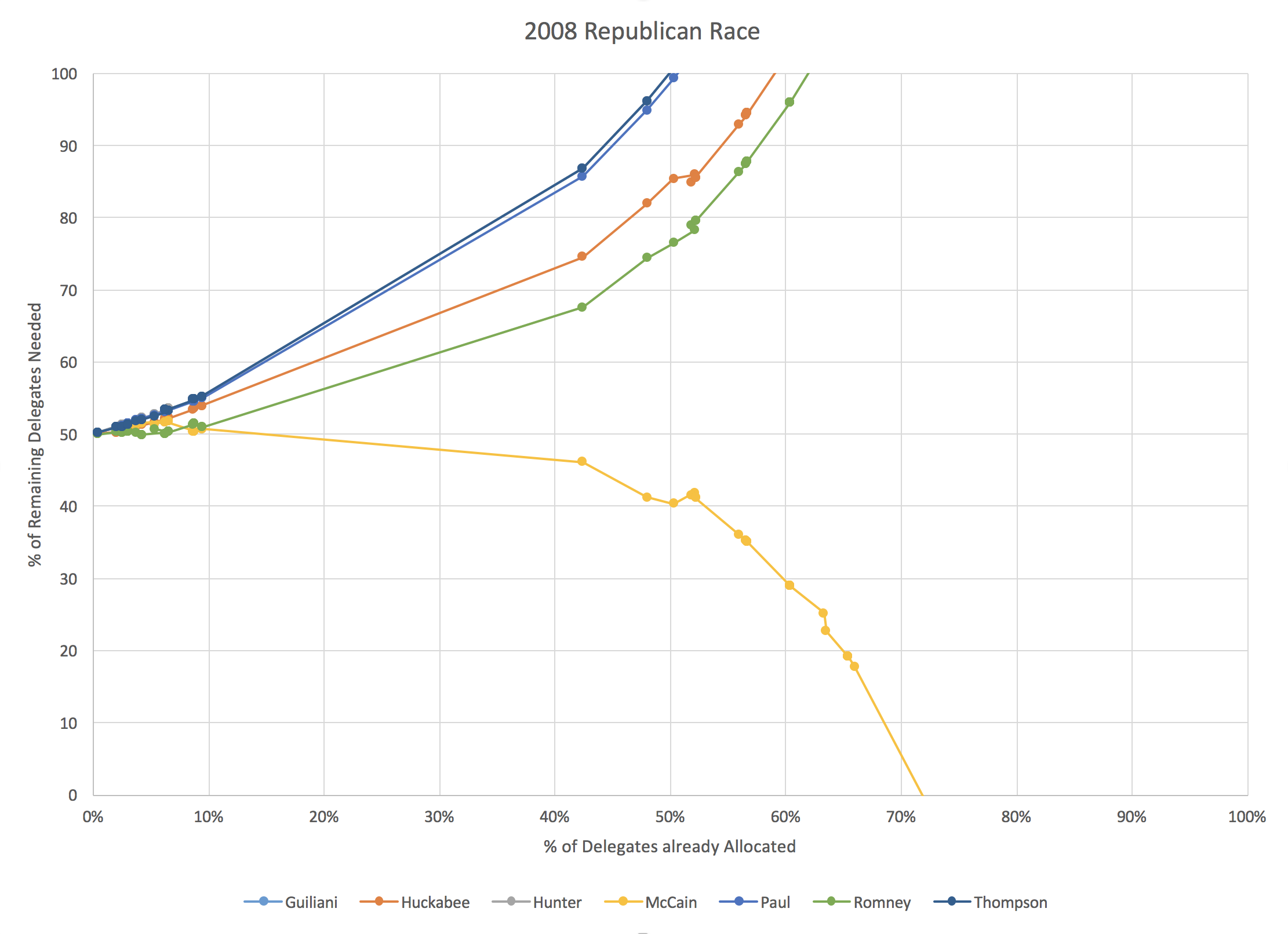
We are currently at the point where about 29% of the delegates have been allocated. Super Tuesday was bigger in 2008, so we don’t have a data point between about 10% and 42%, but you can see that in that Super Tuesday event, McCain took a clear lead, leaving all of the competitors behind. Although things were still a muddle before Super Tuesday, from that point forward there was no stopping McCain. His dominance was unmistakeable.
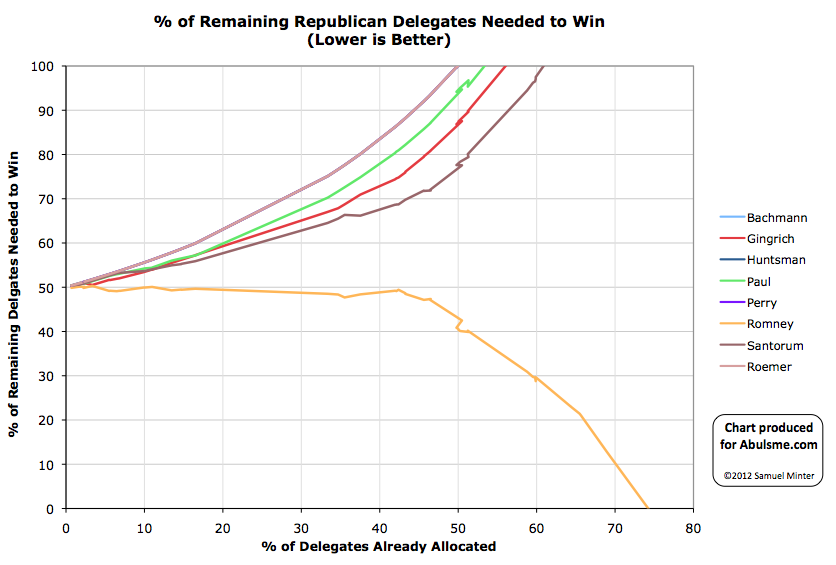
In 2012, Romney was over 50% of delegates earned almost from the very beginning. He continued to hover just below 50% of remaining delegates needed to win though, leading for continued talk of a possible brokered convention for awhile longer. It took until we got past 45% of delegates for Romney to really pull away and eliminate that possibility, making it a clean win.
2012 is probably the closest parallel to where we are today, but Romney never dropped below 50% of delegates after that first few percent at the beginning of the race. Trump is weaker than that at the moment… and his opponents are stronger. But the gap isn’t large. He trails Romney, but not by much.
We’re going to go from just under 30% of delegates determined today, to just under 60% after March 15th. Things will move very quickly, and if there really is going to be a good chance of a contested convention, the groundwork will be laid in these two weeks. If the non-Trumps want to stop Trump, that almost certainly needs to be the game plan at this point. And it has to start bearing fruit NOW.
[Update 2016-03-03 02:34 UTC – The 6 TBD delegates in Tennessee and Texas have been resolved, and there were other adjustments as results continues to be tabulated. Net changes happened in four states: Arkansas (Trump -1, Cruz +1), Massachusetts (Trump +1, Carson -1), Tennessee (Trump +2, Cruz +2, Rubio -1) and Texas (Cruz +4, Trump +2, Rubio -3). Total change for this update: Cruz +7, Trump +4, Carson -1, Rubio -4. New overall delegate totals are: Trump 338, Cruz 235, Rubio 113, Kasich 27, Carson 8, Bush 4, Fiorina 1, Huckabee 1, Paul 1. These changes do not substantively change the analysis above.]
[Update 2016-03-04 02:53 UTC – Update for Georgia: +1 Cruz, -1 Rubio.]
Note: This post is an update based on the data on ElectionGraphs.com. Election Graphs tracks both a poll based estimate of the Electoral College and a numbers based look at the Delegate Races. All of the charts and graphs seen in this post are from that site. Additional graphs, charts and raw data can be found there. All charts above are clickable to go to the current version of the detail page the chart is from, which may contain more up to date information than the snapshots on this page, which were current as of the time of this post. Follow @ElectionGraphs on Twitter or like Election Graphs on Facebook to see announcements of updates or to join the conversation. For those interested in individual general election poll updates, follow @ElecCollPolls on Twitter for all the polls as they are added.
Yeah yeah, Super Tuesday. Yeah, yeah, all the other states coming right afterwards. But we have new general election polls!
Since my last update there have been new polls in Michigan, New Hampshire and Kansas. From all of this, two major candidate pairs had changes to their summary status on my site. And this time, that includes the frontrunners:
Clinton vs Trump
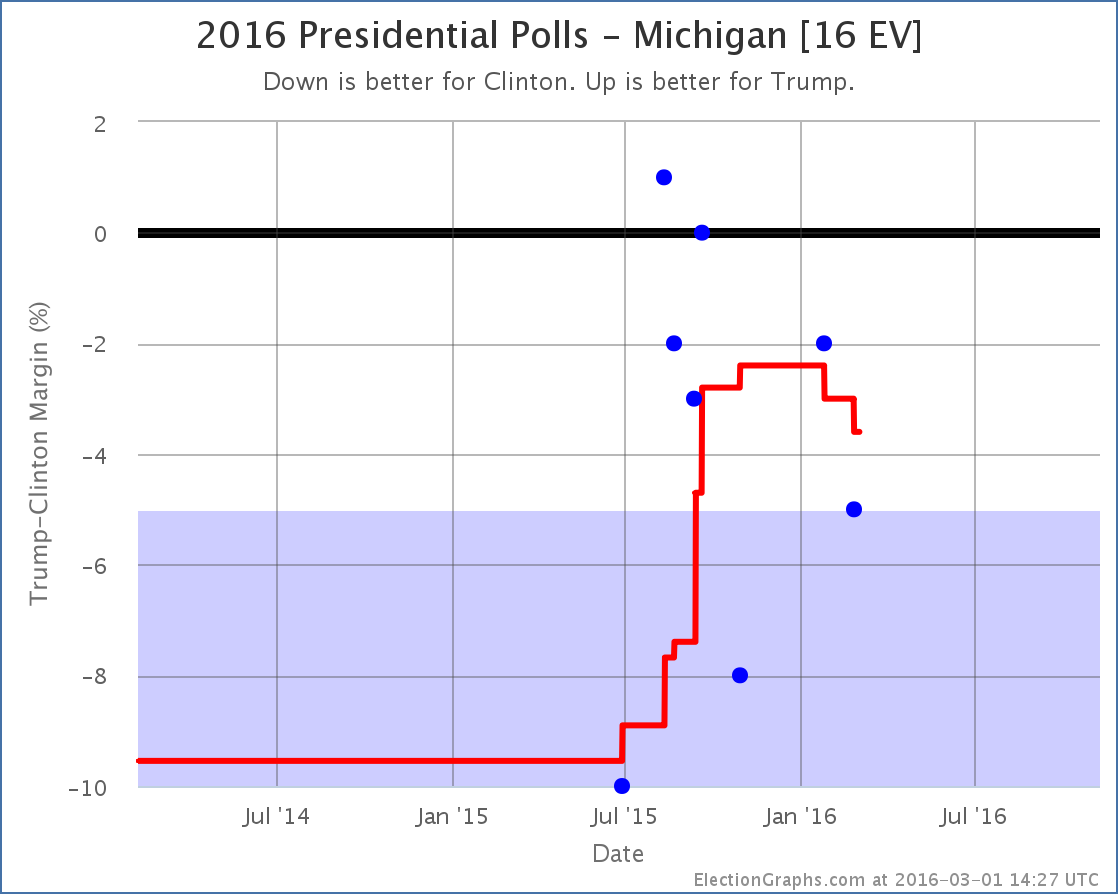
The categorization of Michigan did not change. “Weak Clinton” before, “Weak Clinton” now. But Michigan was the tipping point in Clinton vs Trump, so when Michigan moves, so does the tipping point:
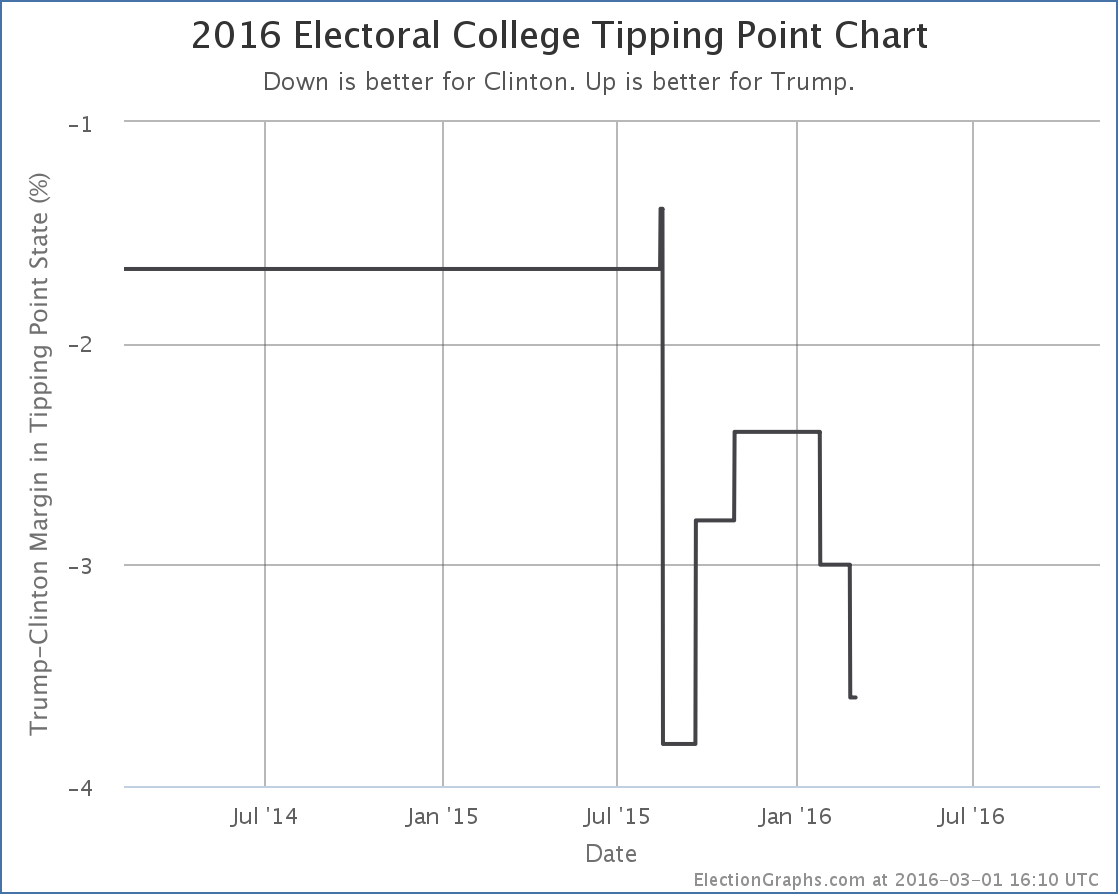
The tipping point moves from a 3.0% Clinton lead in Michigan to a 3.6% Clinton lead in Michigan. Either way, 3.6% is still a narrow lead. Only 1.3% of people changing their minds, or undecideds flipping the right way, would put Trump in the lead. The question is if we are now in a trend away from Trump in this metric, or if we are just bouncing around in a range as new polls jitter the averages. Too soon to tell. But once the primary races are both settled to the point where it is hard to deny the winners are the winners, we will start seeing an acceleration of general election polling, and we should start to see if there are really any trends here.
Clinton vs Rubio
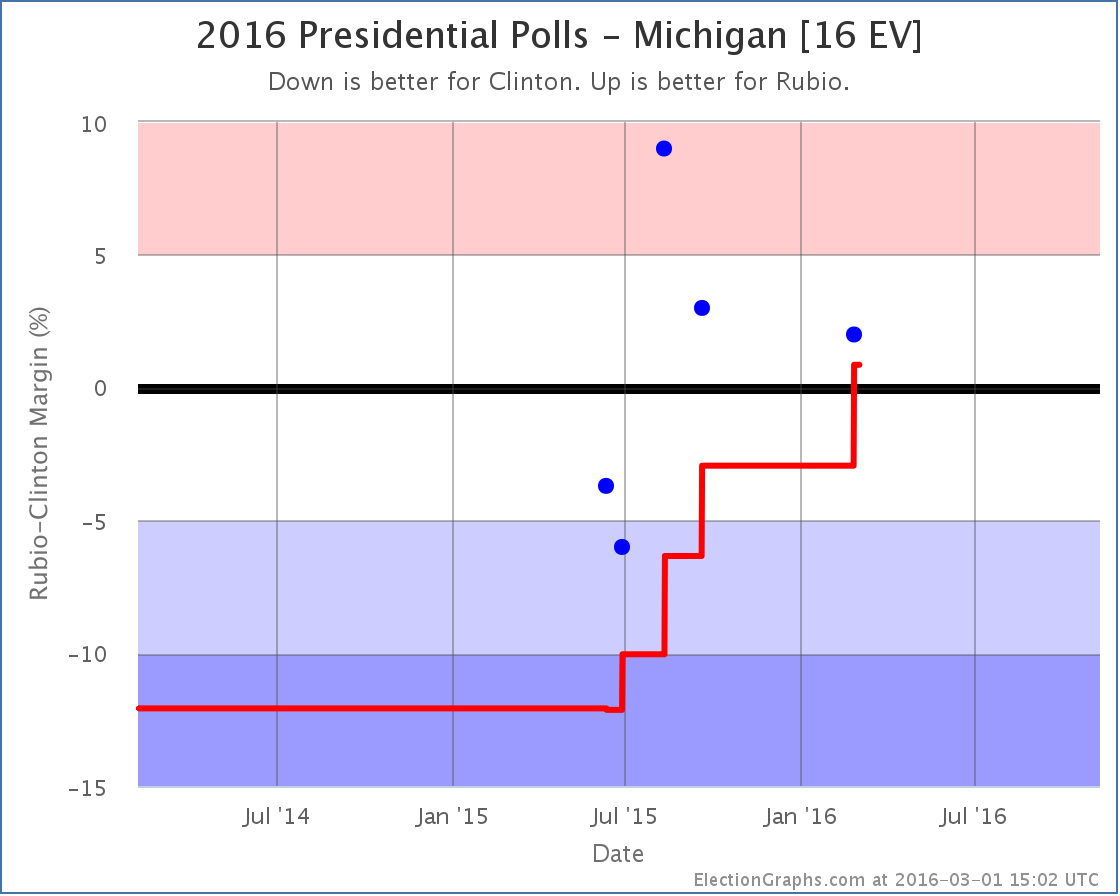
With the latest Michigan poll, Rubio leads in the poll average, which now shows a 0.9% Rubio lead. This moves Michigan from “Weak Clinton” to “Weak Rubio”. It is a close state that could easily go for either candidate, but with this change we move Michigan’s 16 electoral votes into Rubio’s column for the “expected” case where each candidate wins every state they are ahead in.
The move is extra significant this time because it actually puts Rubio over the top to win the whole shebang:
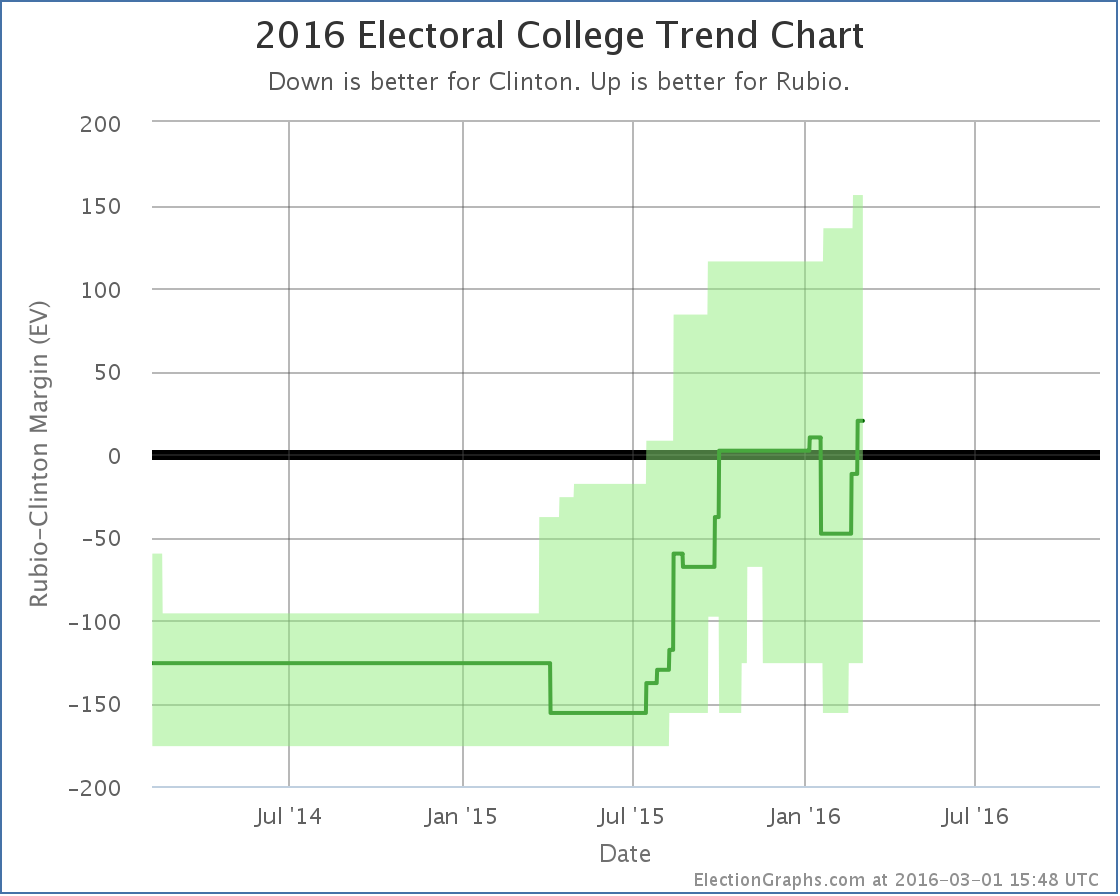
With this, the range of possible outcomes that seem reasonably possible is still everything from Clinton winning by 126 to Rubio winning by 156, but the expected result is now a Rubio win by 20 electoral votes.
This is also reflected in the tipping point:
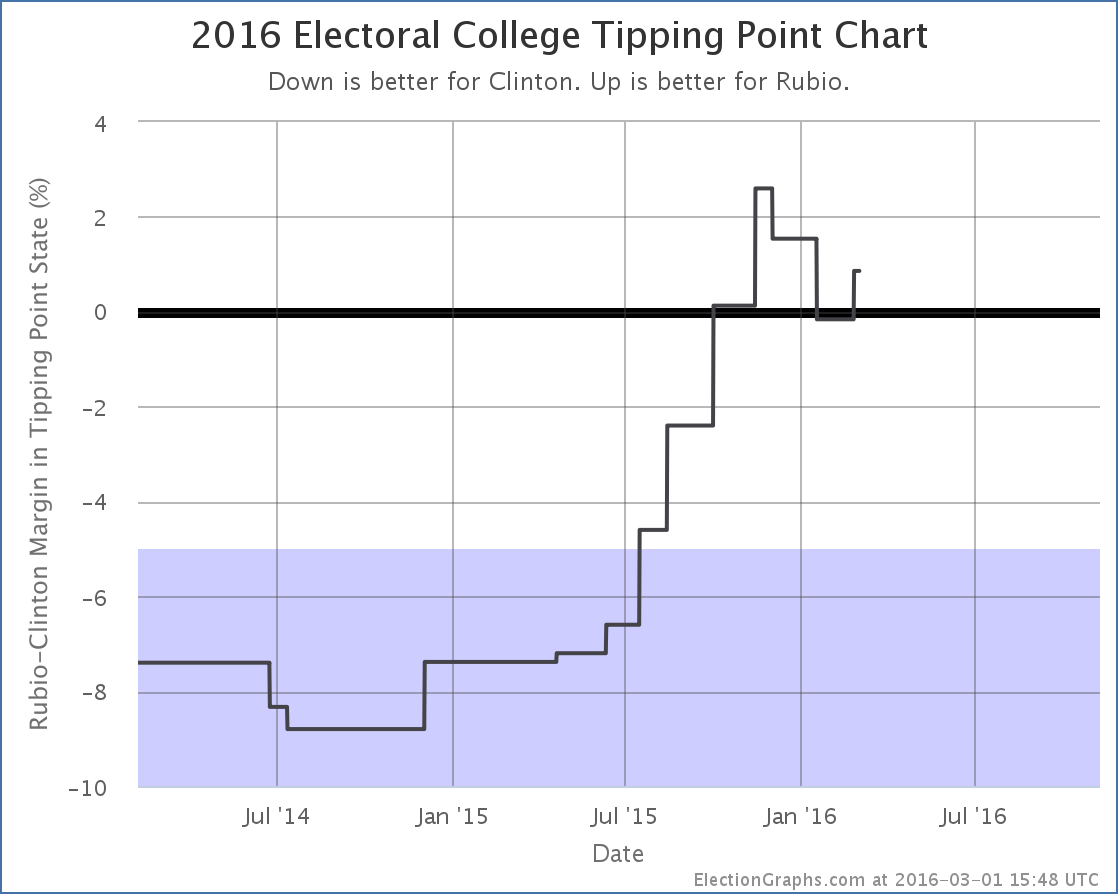
The tipping point moves from Florida, where Clinton led by 0.8%, to Michigan where Rubio is now ahead by 0.9%.
Clinton vs Rubio remains a very close race. But Rubio now has a small advantage.
Others
Clinton vs Kasich is neither a front-running pair, or in the top five best polled combinations, so I won’t consider it fully here other than to note that the latest New Hampshire poll moved Kasich into the lead, changing his expected case from losing to Clinton by 46 electoral votes, to losing to Clinton by 38 electoral votes.
252.2 days until polls start to close on Election 2016.
Note: This post is an update based on the data on ElectionGraphs.com. Election Graphs tracks both a poll based estimate of the Electoral College and a numbers based look at the Delegate Races. All of the charts and graphs seen in this post are from that site. Additional graphs, charts and raw data can be found there. All charts above are clickable to go to the current version of the detail page the chart is from, which may contain more up to date information than the snapshots on this page, which were current as of the time of this post. Follow @ElectionGraphs on Twitter or like Election Graphs on Facebook to see announcements of updates or to join the conversation. For those interested in individual general election poll updates, follow @ElecCollPolls on Twitter for all the polls as they are added.
Once again the headline out of a state is Trump winning. In Nevada the delegate count was:
14 Trump, 7 Rubio, 6 Cruz, 2 Carson, 1 Kasich
To be on the glide path for a 1st ballot victory though, Trump needed 15 of the 30 delegates. So he fell slightly short.
Now, don’t misunderstand. This is still an impressive victory, and looking at the upcoming states he has a clearer path to victory than anybody else. His margins were higher in Nevada than many people expected. But if today’s performance was replicated in all of the other states, Trump would come to the convention with more delegates than anybody else, but not the majority needed to win outright. Of course as we continue more people will drop out, and the amount with which states give bonuses to the winners increases, so that still seems like an unlikely final outcome.
Right now Trump continues to do everything he needs to do to win. Lets look at some of the graphs, then we’ll do a quick look at the March 1st “Super Tuesday” states.
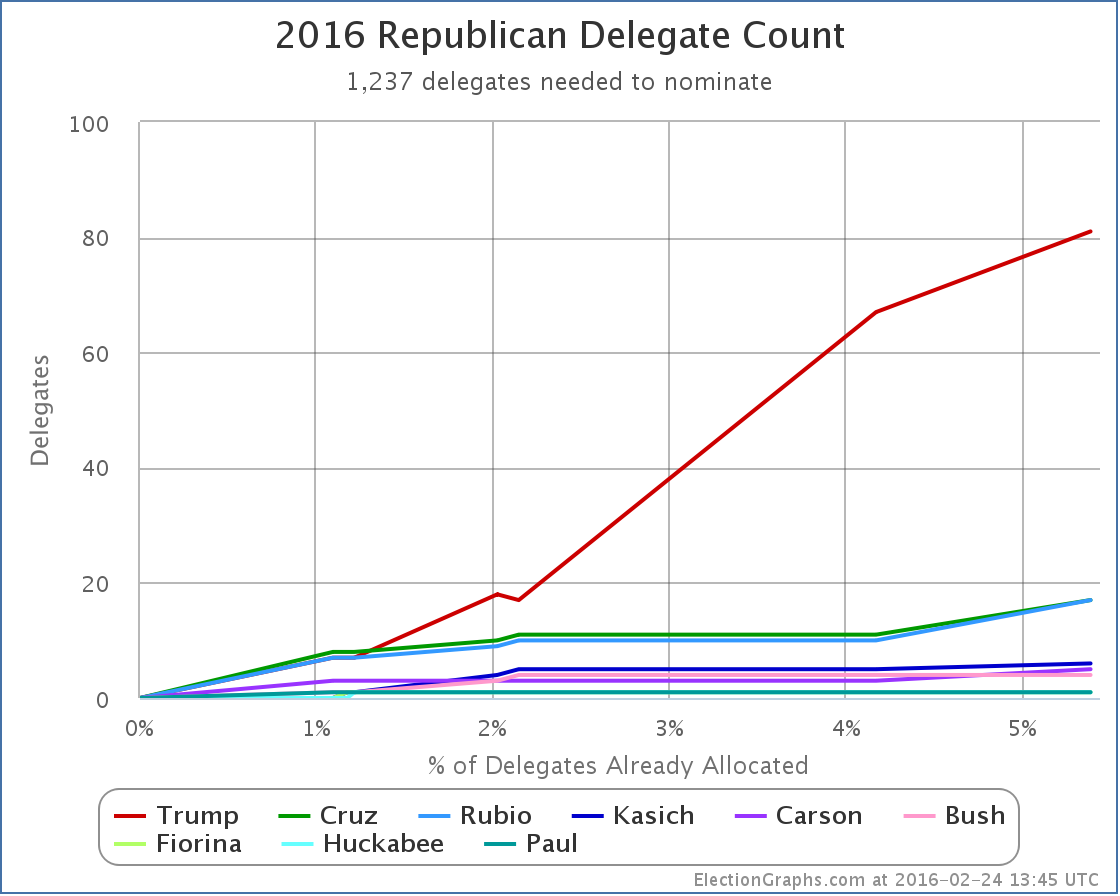
The overall delegate count is now:
81 Trump, 17 Cruz, 17 Rubio, 6 Kasich, 5 Carson, and 7 for people who have dropped out
Trump continues to dominate. Lets look at this as percentages:
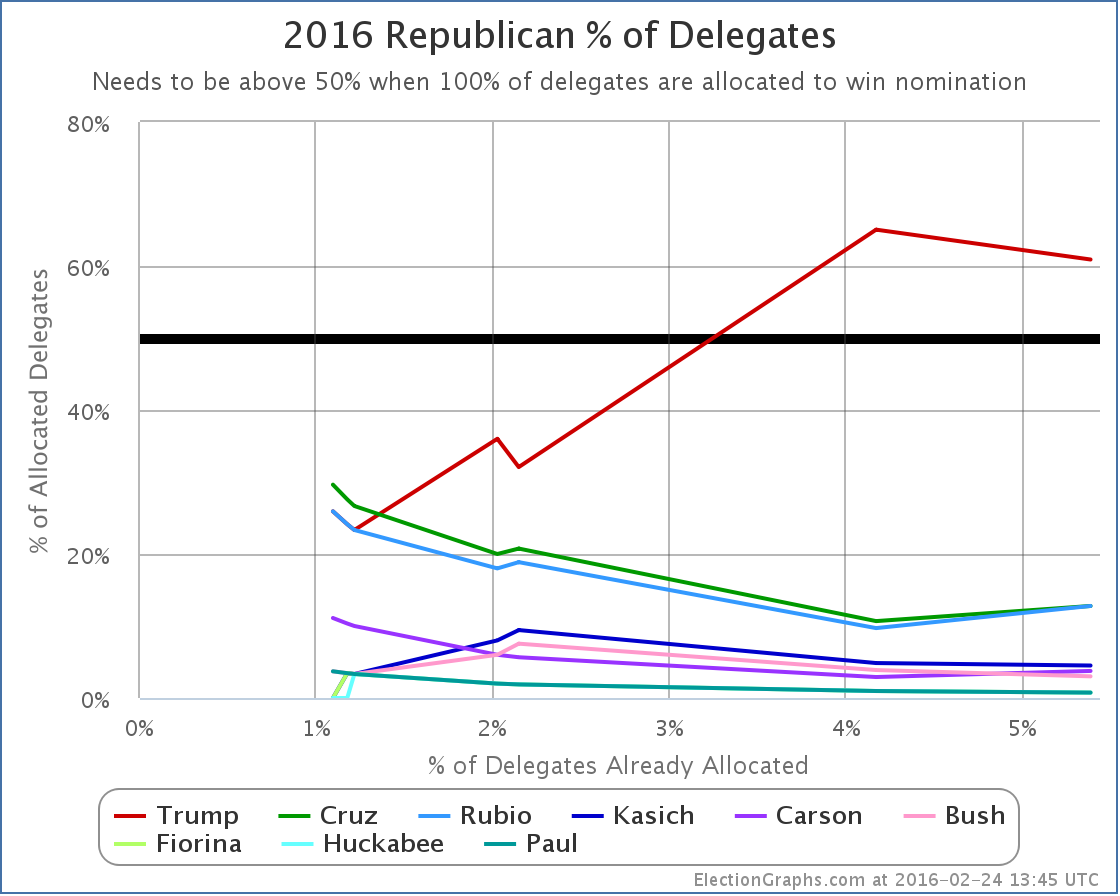
The “winners” here were actually Cruz, Rubio and Carson. Each of them improved their proportion of delegates with Nevada’s results. Trump actually went down. He doesn’t have to worry too much about that though. He still has a majority of the delegates allocated so far, and he is far far ahead of any of his opponents.
Finally, lets look at the “% of remaining delegates needed to win”, which I argue is the single most important thing to look at to understand where the race really is:
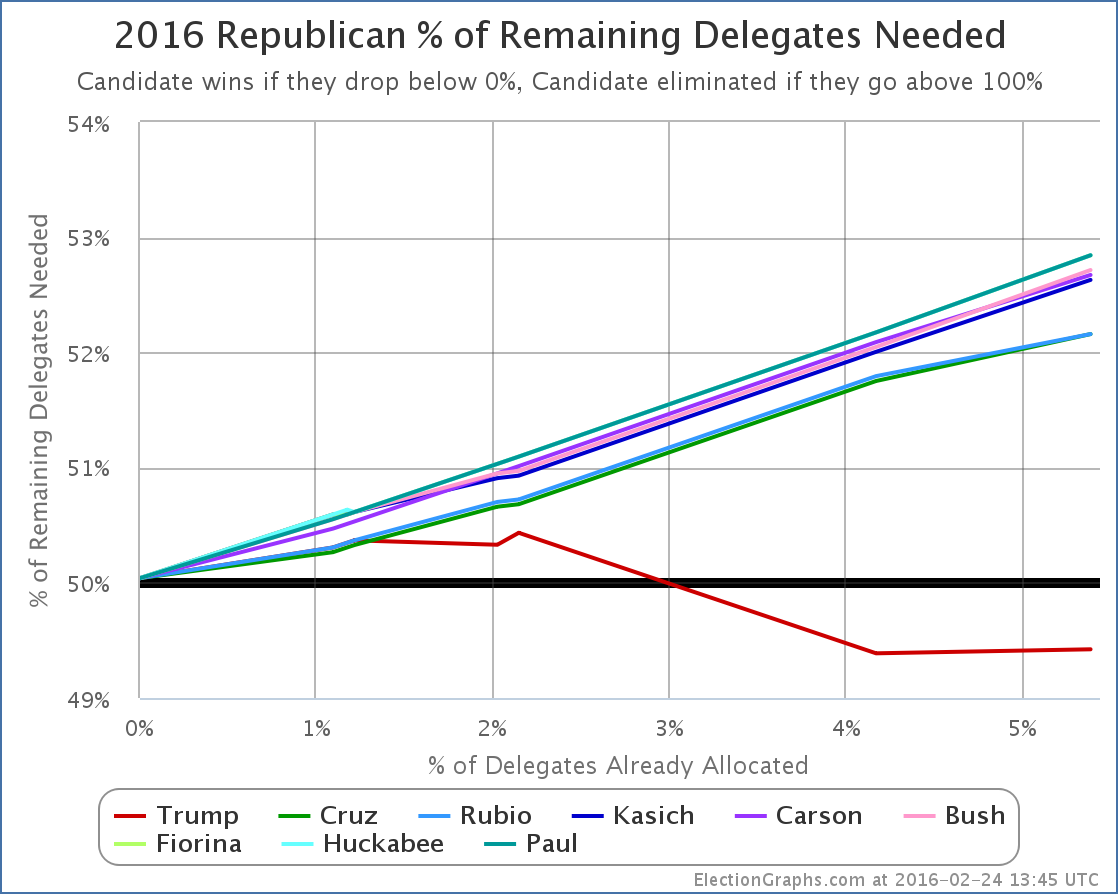
Because Trump got 14 delegates instead of 15 delegates, his line goes up a little bit. (Remember, on this chart down is good, up is bad.) The red line goes from needing 49.39% of the remaining delegates to needing 49.42%. This is a relatively trivial difference though. It is basically flat. Trump’s situation is very close to unchanged.
Meanwhile, the other lines keep going up at a decent pace. Kasich and Carson add about 0.6% to their numbers. Cruz and Rubio add about 0.4%.
This should be obvious, but the more they lose, the harder it is to catch up.
Many people are still talking about how as consolidation happens, the remaining non-Trumps will do better and the picture will change. Maybe, but nobody new announced they were dropping out after the Nevada results (yet anyway). So it looks like we may still go into March 1st with a five person race.
Lets run a hypothetical using current polling on the Super Tuesday states and see where we end up using RCP poll averages for the five remaining candidates. We’ll make delegate estimates based on the specific delegate allocation rules in each state.
Texas (155 delegates)
- Current poll averages: 37.3% Cruz, 28.0% Trump, 11.7% Rubio, 4.7% Carson, 3.0% Kasich
- Delegate estimates: 99 Cruz, 56 Trump
Georgia (76 delegates)
- Current poll averages: 35.0% Trump, 22.7% Cruz, 19.3% Rubio, 7.3% Carson, 6.3% Kasich
- Delegate estimates: 50 Trump, 26 Cruz
Tennessee (58 delegates)
- Last poll from November so using national average: 33.6% Trump, 20.4% Cruz, 16.4% Rubio, 9.8% Kasich, 7.4% Carson
- Delegate estimates: 37 Trump, 21 Cruz
Alabama (50 delegates)
- Last poll from December so using national average: 33.6% Trump, 20.4% Cruz, 16.4% Rubio, 9.8% Kasich, 7.4% Carson
- Delegate estimates: 32 Trump, 18 Cruz
Virginia (49 delegates)
- Using only February poll: 28% Trump, 22% Rubio, 19% Cruz, 7% Kasich, 7% Carson
- Delegate estimates: 17 Trump, 13 Rubio, 11 Cruz, 4 Kasich, 4 Carson
Oklahoma (43 delegates)
- Using only February poll: 32.5% Trump, 25.0% Cruz, 15.5% Rubio, 7.0% Carson, 0.0% Kasich
- Delegate estimates: 17 Trump, 15 Cruz, 11 Rubio
Massachusetts (42 delegates)
- Current poll averages: 41.0% Trump, 17.0% Rubio, 10.0% Cruz, 7.5% Kasich, 3.5% Carson
- Delegate estimates: 23 Trump, 9 Rubio, 6 Cruz, 4 Kasich
Arkansas (40 delegates)
- Using only February poll: 27% Cruz, 23% Trump, 23% Rubio, 11% Carson, 4% Kasich
- Delegate estimates: 18 Cruz, 13 Rubio, 9 Trump (giving Rubio the 2nd place finish breaking 23% tie by alphabetical order)
Minnesota (38 delegates)
- Last poll from January so using national average: 33.6% Trump, 20.4% Cruz, 16.4% Rubio, 9.8% Kasich, 7.4% Carson
- Delegate estimates: 18 Trump, 11 Cruz, 9 Rubio
Wyoming (29 delegates)
- No polls at all, using national average: 33.6% Trump, 20.4% Cruz, 16.4% Rubio, 9.8% Kasich, 7.4% Carson
- Delegate estimates: 12 Trump, 7 Cruz, 5 Rubio, 3 Kasich, 2 Carson
Alaska (28 delegates)
- Last poll from January so using national average: 33.6% Trump, 20.4% Cruz, 16.4% Rubio, 9.8% Kasich, 7.4% Carson
- Delegate estimates: 13 Trump, 8 Cruz, 7 Rubio
Vermont (16 delegates)
- No polls at all, using national average: 33.6% Trump, 20.4% Cruz, 16.4% Rubio, 9.8% Kasich, 7.4% Carson
- Delegate estimates: 10 Trump, 6 Cruz
OK, that’s it. Adding all that up…
Estimated Super Tuesday delegate totals: 294 Trump, 246 Cruz, 67 Rubio, 11 Kasich, 6 Carson
That gives Trump 47.1% of the super Tuesday delegates, Cruz 39.4%, and everyone else much less.
Trump needs 49.4% of the delegates to be on the path to an outright win though! So 47.1% would be in the realm where heading to a contested convention might be possible! Still unlikely, as the additional states in March will add up fast, and more candidates are likely to drop out. Still though, possible!
Adding in the existing delegates, we’d have a post-Super Tuesday race that looks like this:
375 Trump, 263 Cruz, 84 Rubio, 17 Kasich, 11 Carson, 7 for candidates who have already dropped out
Now, these are estimates based on current polling, and very few of these states were well polled as of this post, so much of the above is based on one or two polls, or using the national averages rather than state polls. And I had to make the assumption that all congressional districts would mirror state results (which is unlikely to be true). And Wyoming actually elects individual delegates rather than doing things based on candidate preference, so it may be an oddball in the end. And of course things are likely to change further before people actually vote next Tuesday. But… the general outlines of this aren’t likely to be too far off.
If this is even remotely close to where we are on March 2nd, we end up with Trump very close to the 50% of delegate mark. (The above has him EXACTLY at that mark.) He would need just a LITTLE bit more to actually push him over the edge to a clean win.
The flip side of that though is the combination of all the anti-Trumps would need just a LITTLE bit more in order to have this be on the path to a contested convention. I mentioned earlier that this is still an unlikely outcome. It is. After March 1st, the disproportionality of delegates given to the winner increases, and after March 15th we have pure winner take all states as well. If Trump remains in the overall lead, even with a plurality, then that is all it takes to push him over the edge.
If the anti-Trumps want to have any hope here at all, they need to be in a position by mid-March that they can win not just a few, but many states of the winner-take-most and winner-take-all variety. And frankly, the most likely scenario even then is just forcing a contested convention where Trump still has the most delegates, not someone else winning outright.
The anti-Trumps would have a hard road to get to an outright win. Cruz would need 56.8% of the remaining delegates to catch up and win after March 1st if things played out like my estimates above.
If you had to make a guess based on what we know now, a Trump nomination is far more likely than any other… and with an outright delegate majority on the first ballot, not after a contested convention.
6 days until Super Tuesday. We’ll see how close my estimates above turn out to be.
Update 2016-02-26 07:17 UTC – On February 22nd New Hampshire certified the results of their primary. In the final tally Trump had one more delegate than previous estimates, and Rubio one less. This did not seem worthy of a separate post, but a note here seemed appropriate. The totals on ElectionGraphs.com have been updates appropriately. This does not substantively change any of the analysis above.
Note: This post is an update based on the data on ElectionGraphs.com. Election Graphs tracks both a poll based estimate of the Electoral College and a numbers based look at the Delegate Races. All of the charts and graphs seen in this post are from that site. Additional graphs, charts and raw data can be found there. All charts above are clickable to go to the current version of the detail page the chart is from, which may contain more up to date information than the snapshots on this page, which were current as of the time of this post. Follow @ElectionGraphs on Twitter or like Election Graphs on Facebook to see announcements of updates or to join the conversation. For those interested in individual general election poll updates, follow @ElecCollPolls on Twitter for all the polls as they are added.
[Edit 16:28 UTC to correct math on % of remaining Cruz would need after Super Tuesday, I’d originally shown a higher number around 61%.]
[Edit 2016-02-27 17:06 UTC to fix place where Kasich had been autocorrected to Quash.]
[Edit 2016-02-28 22:03 UTC to add dropped out candidates to the after Super Tuesday estimate.]
|
|

























